
Throughout history, individuals have always had an abundance of inquiries when it comes to observing the celestial sphere. What exactly are those twinkling dots in the night sky? Why does the sun rise and set, causing the transition from day to night? Could there possibly be other planets in close proximity, and if so, is there a chance they sustain life? By studying these luminous entities, humans have gleaned a wealth of knowledge about them. This lesson will delve into the perpetual questions that have captivated our minds for centuries. We will explore the Earth’s place within the vast universe, as well as its precise shape and dimensions. Furthermore, we will examine the Earth’s movement and the subsequent impacts it has on our daily lives.
The Solar System: Earth and its Components
When we gaze up at the night sky, we are captivated by the moon’s luminosity and the countless stars that adorn the darkness. It’s a breathtaking sight that evokes a sense of infinitude. However, what we see is merely a fraction of the vast expanse that is the universe – a term coined by the ancient Greeks as cosmos.
Within this boundless universe, Earth takes its place as a planet within the solar system. The solar system consists of various celestial bodies, including the Sun, nine major planets, asteroids, comets, and meteoric bodies. Now, let’s delve into the intricacies of the Solar System’s structure.
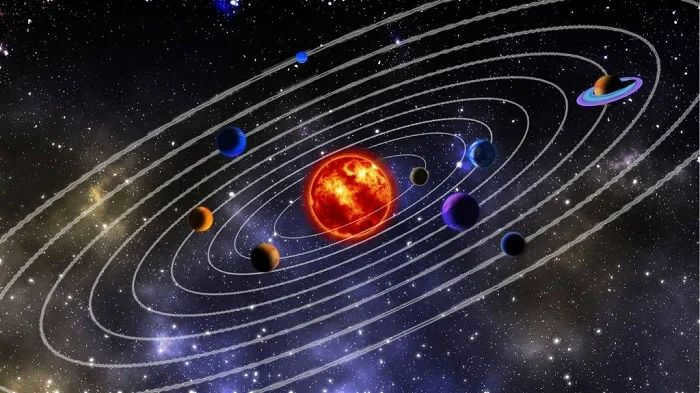
- Which part of the Solar System is of utmost importance? The Sun, a star in close proximity to our planet, is considered to be the central component. This celestial body can be likened to a scorching orb within the solar system. Its surface temperature reaches a staggering six thousand degrees, with even hotter conditions within. Consequently, the star emits light that travels at an astounding velocity. It takes approximately eight minutes for this light to reach our planet.
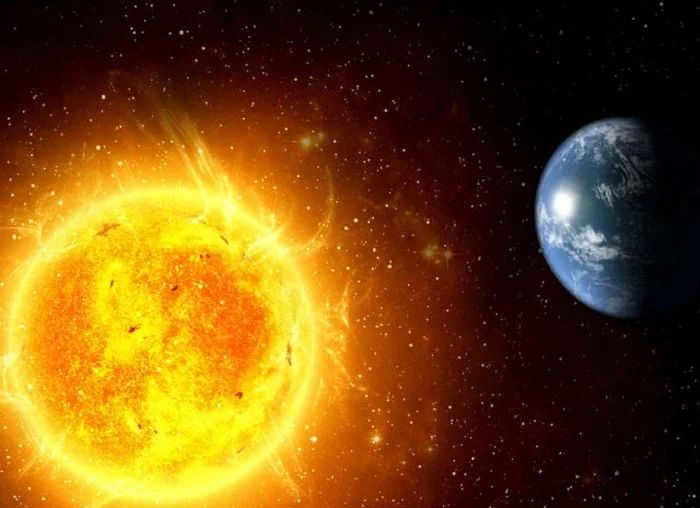
The Sun
- The Sun is orbited by planets, which are dense spherical bodies. The solar system contains both large and small planets. Earth is one of the major planets in the solar system, along with 8 others. Let’s take a look at the figure to get acquainted with the large planets in the solar system.
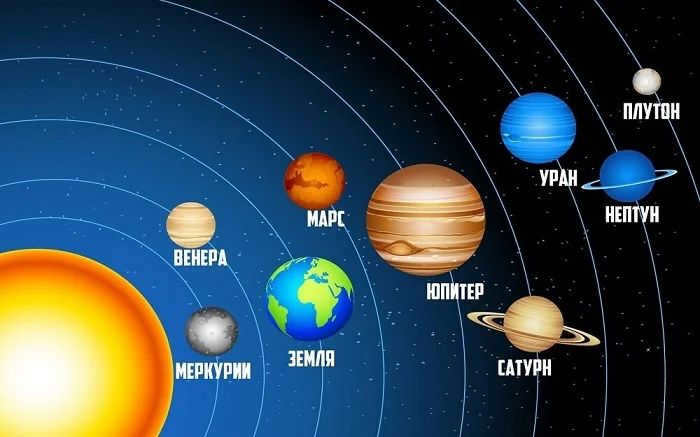
Source of large planets
The visual representation clearly depicts the magnitude of the planets. Within our solar system, there exist celestial bodies that surpass Earth in size.
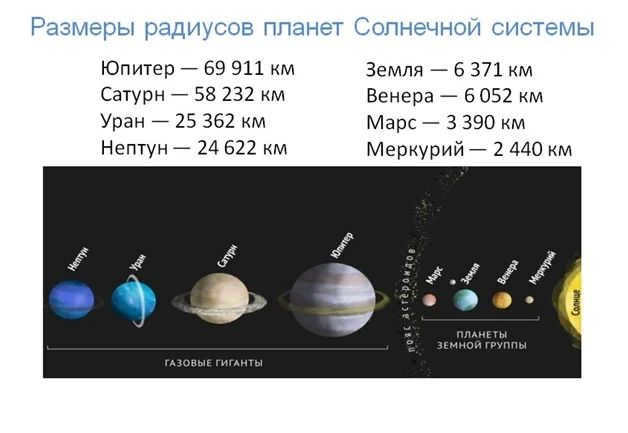
There are numerous planets that have their own satellites. Jupiter, for instance, boasts a total of twelve satellites, while Saturn has nine. Earth, on the other hand, has the Moon as its one and only satellite.
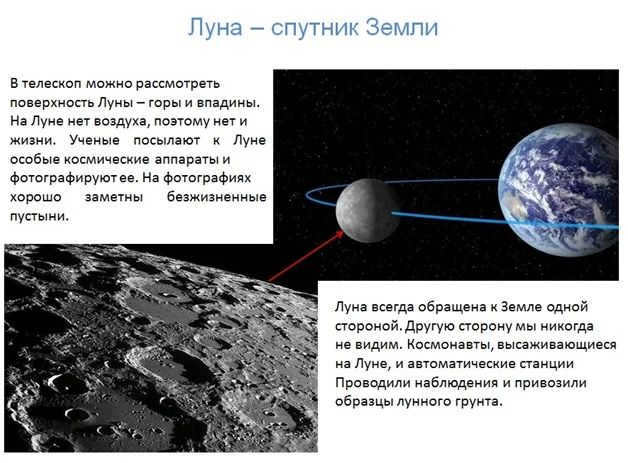
Out of all the celestial bodies in the solar system, Earth holds a special status due to its unique feature of hosting diverse life forms. The question regarding the shape of our planet has intrigued mankind since ancient times. The spherical nature of Earth was eventually proven by the explorer Fernando Magellan. However, curiosity extended beyond the shape to encompass the size of our planet as well. The scholar Eratosthenes made highly accurate calculations to determine the radius of the Earth, which still hold up to this day despite the advancements in modern technology. It is worth noting that in terms of mass, Earth occupies the fifth position among all the known planets.
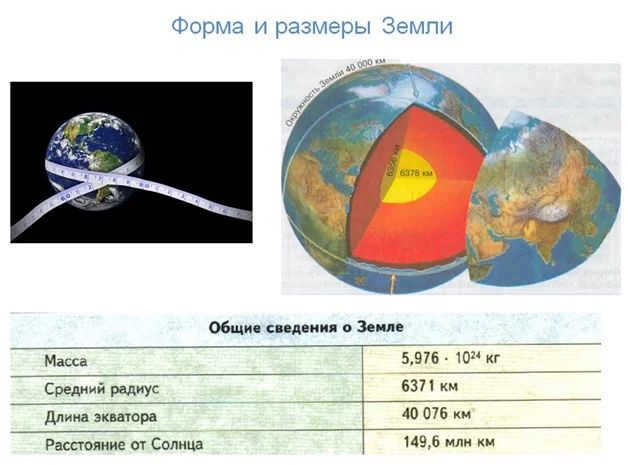
- In the universe, there are additional celestial objects that do not produce any visible light. This category encompasses small planets or asteroids, comets, and meteors.
Within the solar system, there are approximately 1600 small planets.
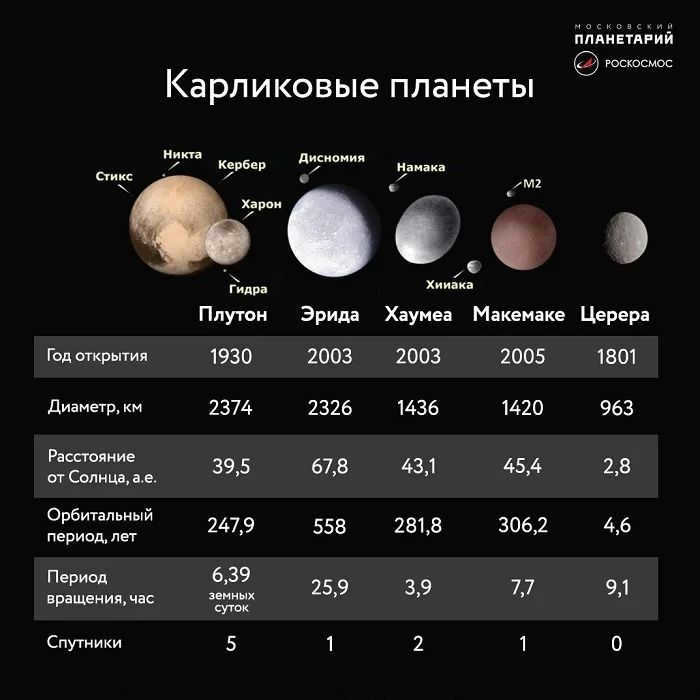
Source
Comets, celestial bodies with long tails, are frequently observed in the sky. Comets are composed of a solidified gas nucleus and a tail made up of a stream of gases and dust particles. The appearance of a comet has historically been associated with various superstitions. For instance, it was believed that the presence of a comet foretold misfortune such as disease, famine, or war. There was also a fear that a comet could collide with Earth and result in mass extinction. However, such events have not occurred in centuries, rendering these fears mere fiction.
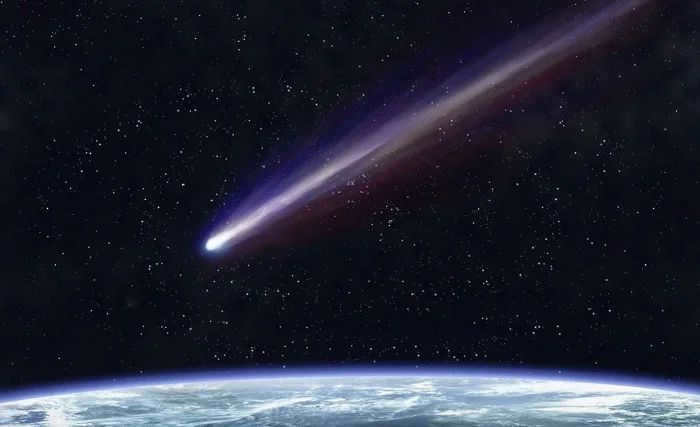
Comets
Meteorites are pieces of comets and asteroids that have landed on the planet’s surface. They consist of elements such as iron, copper, phosphorus, and other substances. Meteorites descend to Earth from the interplanetary space within the solar system. Upon entering the atmosphere, they may disintegrate into numerous tiny fragments, creating meteor showers.
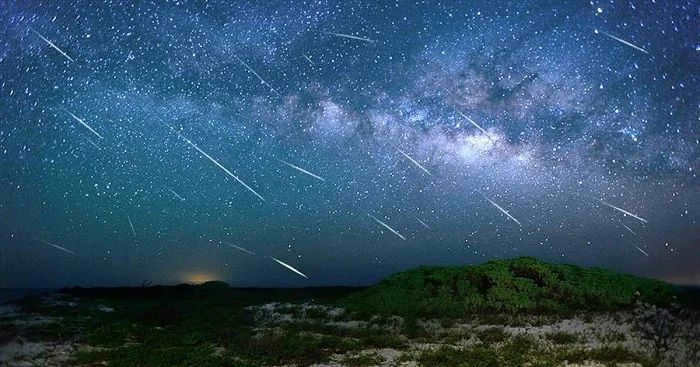
Meteor shower
Deep space is filled with celestial objects, including stars that are spherical in shape and composed of gases. These stars can vary in size, brightness, and distance from our planet. The Sun, our closest star, is of average size.
The stars in the sky are organized into patterns called constellations, which are named based on their shapes. For instance, the Big Dipper constellation resembles a ladle, but when we connect all the stars, it forms the shape of a bear.
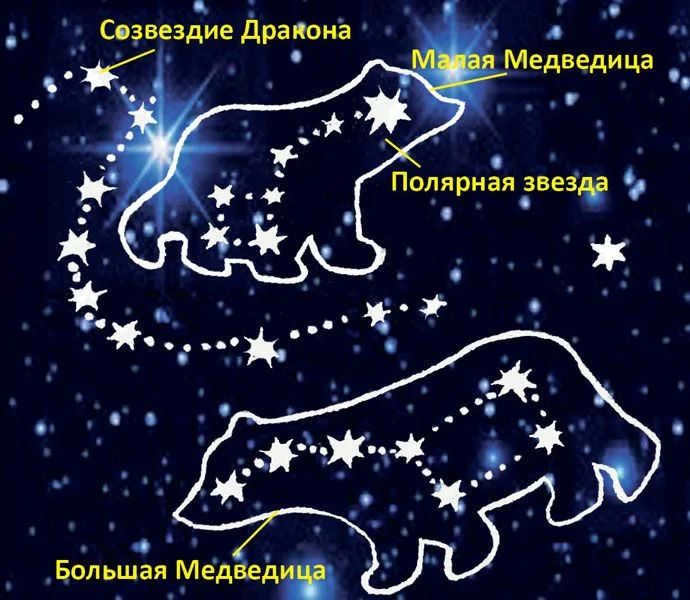
Source
The Earth’s axial movement
In the 17th century, thanks to the discoveries made by Galileo, it was discovered that it is not the celestial bodies that revolve around us, but rather the Earth rotates around its axis.
The axis is typically defined as a rod located at the center of an object. It is the axis around which movement occurs. We can observe it in various objects, such as the wheel of a bicycle or a stroller. The Earth’s axis is not a physical rod, but rather an imaginary line, and it is slightly tilted.

The Earth is divided into two parts by an imaginary line known as the axis of rotation. This line extends from the North Pole to the South Pole, marking the two ends of the planet. In the middle, at an equal distance from the poles, lies the equator – a circle that divides the Earth into the northern and southern hemispheres.

The planet Earth completes a full rotation on its axis without us even realizing it. The rotation is incredibly smooth, and we are carried along with it.
In the past, it was commonly believed that celestial bodies moved from east to west. However, we now know that the Earth’s axial motion actually goes from west to east. This means that as the Earth rotates, different parts of it become illuminated while others are plunged into darkness. The illuminated areas experience daytime, while the areas without light experience night. This continuous cycle of light and darkness is what causes the change between day and night. The Earth’s axial motion is also known as diurnal or daily motion.
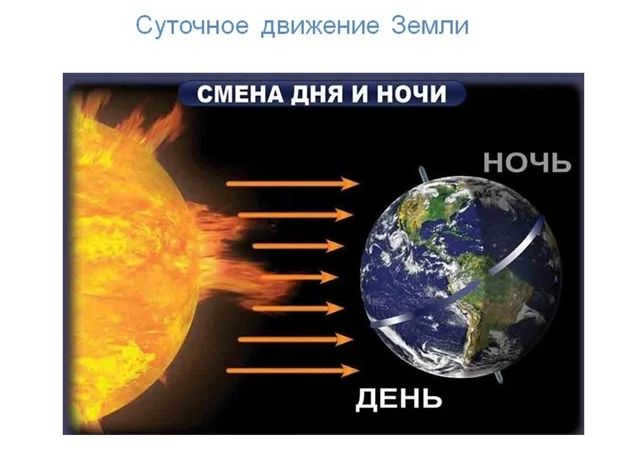
The planet Earth completes one full rotation on its axis within a span of 24 hours, commonly referred to as a day. The velocity at which the Earth rotates can vary depending on the location. For instance, at the equator, the rotational speed is approximately 1600 km/hour.
Whenever an object is in motion, it experiences centrifugal force, which causes the planet to expand around the equatorial region and flatten at the poles. As a result, the Earth’s shape is not perfectly spherical, but rather oblate spheroidal, a consequence of its rotational motion.
In addition to the Earth’s axial motion, there is also the Earth’s orbital motion. The path that the Earth follows while circling the Sun is known as an orbit.
The duration of the Earth’s orbit around the Sun is 1 year. A solar year consists of 365 days, 5 hours, 48 minutes, and 46 seconds. Therefore, it is customary to have 3 years of 365 days each, with the 4th year being 366 days. This special year is referred to as a leap year.
The velocity of the Earth’s revolution is 30 kilometers per second.

The Earth’s revolution around the Sun is the source of the change in seasons. The tilt of the Earth’s axis is what determines the length of each season. Kids often wish it could be summer all the time, but unfortunately that’s not the case. After a hot summer comes a cool fall, followed by a frosty winter. Then the icy winter gives way to a warm spring and summer. The Earth’s orbit around the Sun takes a year, so the cycle of seasons happens in a systematic way.
One consequence of the Earth’s orbit around the Sun is that it leads to uneven heat distribution in different hemispheres.
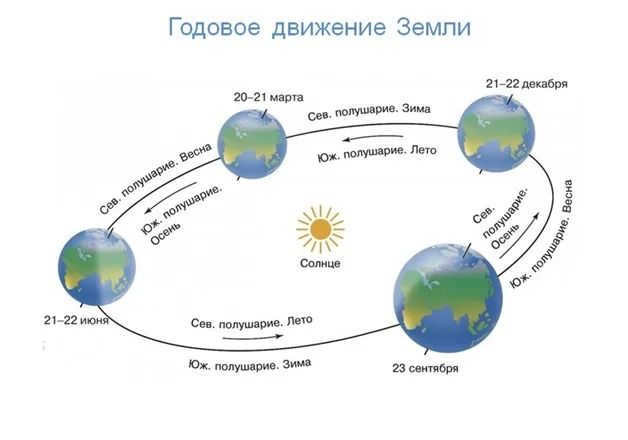
Here you can observe the illustration depicting the illumination of the planet. The country of Russia is situated in the northern hemisphere. When the planet rotates with this side facing the Sun, it experiences a greater amount of warmth, leading to the arrival of summer. The Earth completes its orbit around the Sun within a specific time frame and subsequently shifts to the opposite side. Subsequently, winter arrives in our hemisphere.
The disparity between the duration of daytime and nighttime is influenced by the tilt of the Earth’s axis. Frequently, terms such as solstice and equinox are used to describe these phenomena.
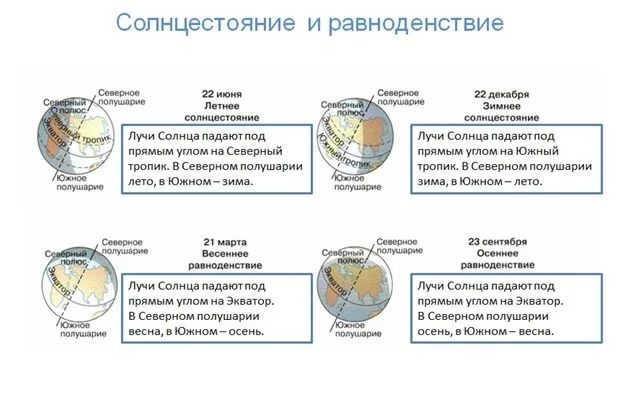
Let’s imagine a scenario where the Earth ceases its orbit around the Sun or its rotation around its axis. In this situation, the planet would become fixed in a position where one side is constantly exposed to the source of light. As a result, the temperature on this side would skyrocket, exceeding 100 degrees, causing all the water to evaporate. On the other side, which remains in perpetual darkness, a process of glaciation would occur.
Based on the information presented, it becomes evident that all forms of Earth movement play a crucial role in sustaining life on the planet.
The Impact of Space on Earth and Human Life
Throughout history, humans have always been fascinated with the mysteries of space and how it affects life on our planet. Despite the advancements in technology, our understanding of the influence of space on Earth remains limited. The Solar System, which is the closest part of the cosmos to us, is the most well-studied in terms of its influence.
- Space exerts a gravitational force that attracts the Moon, the Sun, and the Earth, resulting in tidal phenomena in the world’s oceans. Tides occur when water in the seas and oceans rises and falls twice a day, causing periodic flooding of low shores. These regular changes in water levels are known as tides.
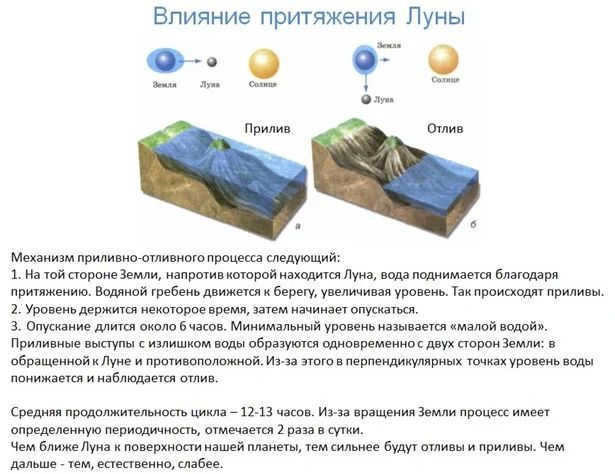
The influence of outer space on planet Earth is a phenomenon that humans have harnessed for their own benefit. Tidal movements provide a source of renewable energy, which is harnessed through the use of environmentally-friendly facilities such as tidal hydroelectric power plants.

A tidal power plant in France
- The impact of outer space can also be observed in the heat that reaches our planet. We receive this energy from the sun, which acts as a heat source and the primary catalyst for the various processes occurring on Earth. Without it, we and all other living organisms would be unable to survive.

Deer
The radiation emitted by the celestial luminary spreads out in all directions. If the Sun were to cool down, our planet would be enveloped in darkness. The absence of heat would cause the extinction of living organisms due to the cold. This would lead to another ice age.
There is another aspect to the Sun’s impact on Earth from outer space. The Sun’s radiation includes a significant amount of ultraviolet light. However, our planet is shielded by the ozone layer, which allows only a small portion of ultraviolet radiation to reach the surface.
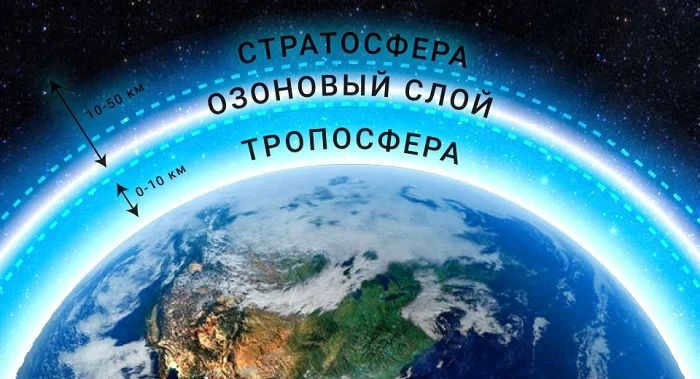
Source
Despite all that has been said, if there are any gaps in this protective shield, living organisms will be subjected to various degrees of burns. Humans have a significant impact on the space environment, and as a result, the ozone layer is gradually thinning. The pollution of our habitat is contributing to this process. Therefore, it is imperative to address environmental issues on our planet in order to preserve life.
- The sun emits streams of charged particles towards the Earth. From the depths of space, invisible rays penetrate the Earth’s upper atmosphere and have an impact on human life. These streams create magnetic storms, auroras, and other phenomena.
Magnetic storms originating in space have a significant impact on the human body in various ways.

Source
Individuals suffering from cardiovascular and neurological conditions typically exhibit a response to these phenomena. They may encounter symptoms such as headaches, fluctuations in blood pressure, excessive fatigue, and even fainting.
- The planet Earth, due to the force of universal gravitation, exerts its influence on celestial bodies, while other cosmic entities impact its existence as well. For instance, meteorites have the potential to collide with the Earth’s surface, causing extensive damage. An example of this occurred in 1908 with the Tunguska meteorite, which created a massive crater upon impact, obliterating trees in the surrounding area.
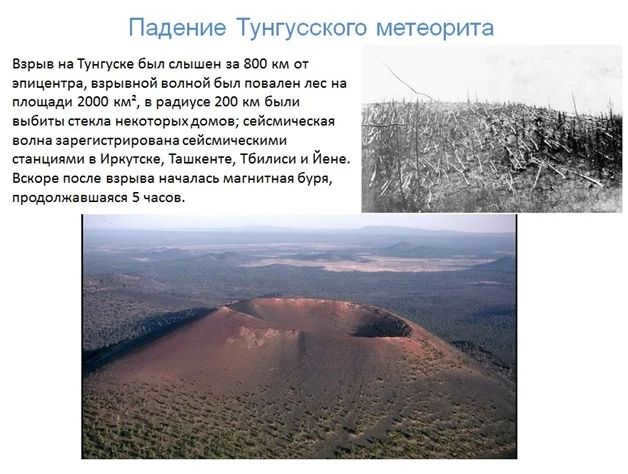
The impact of the vast expanse of space on human life and the Earth is still not fully understood. For centuries, humanity has been exploring the cosmos and pondering the existence of life on other planets. Currently, scientists can only speculate that there may be one inhabited planet for every million stars. Hopefully, in the coming years, the enigmas and secrets of the universe will be unravelled.
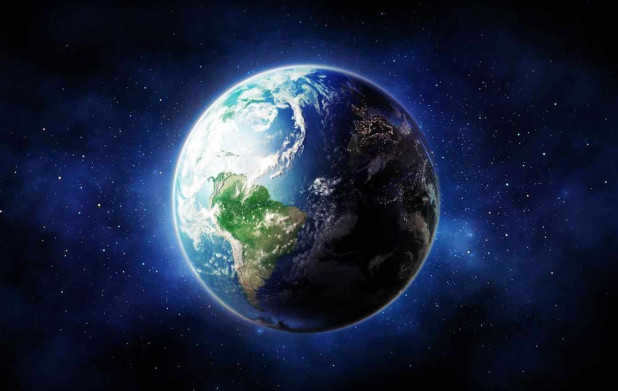
Our planet is known as Earth. It is regarded as the sole planet where humans and other living beings can inhabit among all the known planets. All planets orbit around the Sun. Earth is situated at a distance of 149.6 million kilometers. It is the third farthest from the largest star. The population of planet Earth is 7.6 billion individuals. And the count is still increasing. From outer space, Earth looks blue in hue, this is due to the fact that a majority of it is covered by water. Hence, the planet is referred to as the “blue planet”.
The Origin of the Planet’s Name
Terra is another name for Earth, derived from the Latin word “firmament”.
The English term for our planet is Earth, which means “soil”. In Ireland, it is referred to as Domhan, meaning “main house”.
In ancient times, people believed in deities who were believed to protect the planets. The word Earth comes from the root ZEM, which signifies bottom, floor, and soil. Hence, the term “earth” refers not only to the name of the planet but also to its surface layer.
In the past, when viewed from space, our planet appeared multicolored rather than blue. It was known as “Radaga” (with “ra” denoting deity, “da” meaning giver, and “ga” representing existence).
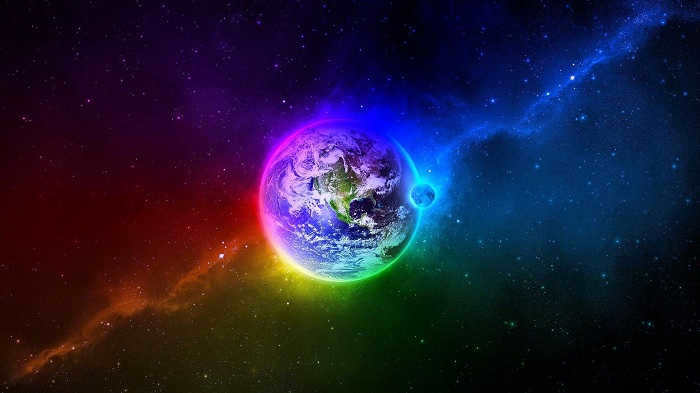
That was the case until Radaga collided with a massive small planet careening haphazardly through the vastness of space. Following this cataclysm, Earth became inundated, underwent a drastic change in color, and appeared partially devastated. Over time, it was repopulated by dinosaurs and serpents.
Thus, the name “Earth” came into existence, where “zem” referred to “serpents” and “la” meant “lying”. In other words, lying beneath serpents or pertaining to serpents. The credibility of this theory remains uncertain.
There is another possibility as to why the Earth is named as such. Humanity could only thrive thanks to the bountiful offerings of the earth. In essence, they subsisted on what they cultivated from the soil.
The misconception about the shape of the Earth, with the belief that it was flat, has been prevalent for a long time. It was referred to as “the world beneath our feet”, encompassing everything that surrounds us.
Ancient Beliefs Regarding Earth’s Shape
The Greeks were the first to propose the idea that the Earth is spherical. Aristotle, a Greek scientist, argued that the Earth is not flat but convex. He suggested that it is the center of the world, with all other planets and the Sun revolving around it.
Prior to Aristotle, the Greeks believed that the Earth was a flat disk surrounded by the sea. They believed that the stars emerged from this disk in the evenings and returned to it in the mornings.
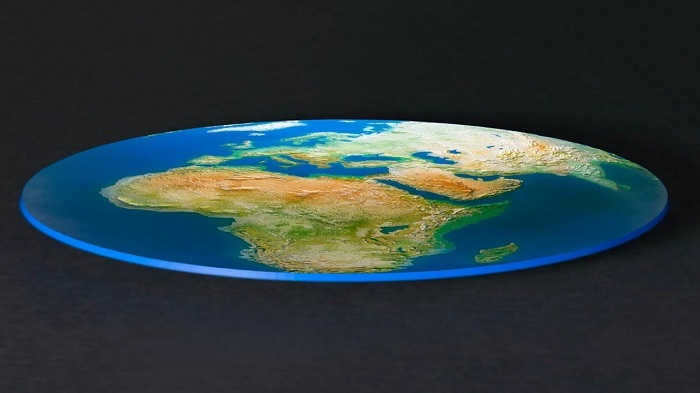
Back in ancient India, there was a belief that the Earth took the form of a hemisphere, supported by four majestic elephants. These elephants, in turn, were perched atop a giant tortoise, while all of them were encircled by a formidable black cobra with numerous heads.

There was a belief among certain individuals that the planet Earth was sustained by three enormous whales that roamed the depths of the ocean.
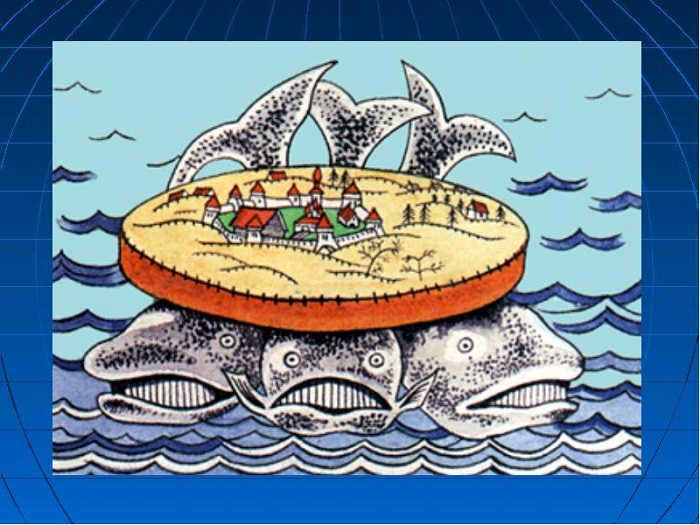
The concept of a flat Earth was a prevailing belief until the 6th century BC, when Pythagoras of Samos introduced the idea of the planet’s spherical nature.
Aristotle, following Pythagoras, provided evidence to support this notion. He observed that ships appeared to disappear behind the horizon line, rather than gradually fading away as they moved further away.
The scientist also noted that the shadow cast by the Earth on the Moon was always round, a shape that can only be produced by a spherical object.
Furthermore, Aristotle pointed out that certain stars could only be seen from specific parts of the planet.
These observations laid the foundation for Aristotle’s theory of a spherical Earth.
After a while, a proposal was made by the astronomer Aristarchus of Samos that the Earth does not revolve around the Sun, but rather the other way around – the Sun, along with the other planets, revolves around the Earth. Unfortunately, Aristarchus was unable to provide evidence for this hypothesis. It was not until much later that the Polish scientist Copernicus was able to substantiate this theory.
There are no planets in the solar system that have a square or triangular shape.
What is the shape of all the planets in the solar system?
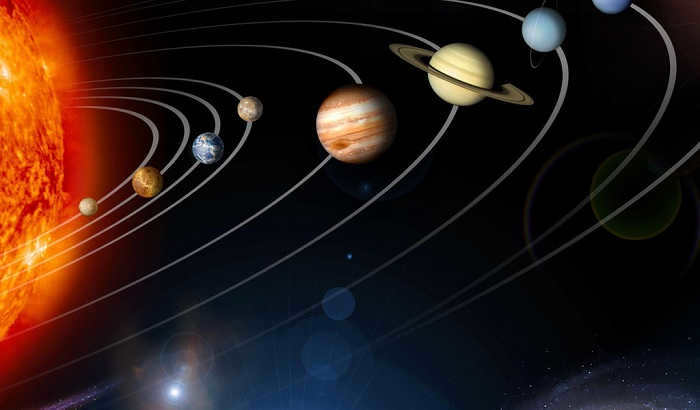
Astrophysicists and astronomers have dedicated centuries of scientific research to unraveling the mystery behind the round shape of planets.
Planets are formed through the accumulation of space dust, debris, and gases. This process began approximately 1.5 billion years ago, with the core being the first to form. Subsequently, the force of gravity, scientifically known as gravitational attraction, started pulling other particles towards the nucleus. As the planet grew in size, its gravitational force became stronger.
Over the course of billions of years, this gradual accumulation and gravitational pull resulted in the formation of spherical planets. Gravity evenly distributed the accumulated particles around the core, forming distinct layers.
The Concept of a Flat Earth
Even in modern times, there continues to be a faction of individuals who firmly believe in the idea of a flat Earth. These proponents argue that our planet is not spherical in shape but rather takes the form of a flat disk. They go further to suggest that the absence of gravity as we understand it is due to the upward motion of the Earth, rather than the attractive force of gravity. In support of their claims, they reference ancient maps that depict the Earth in a flat manner, with the North Pole positioned at the center.
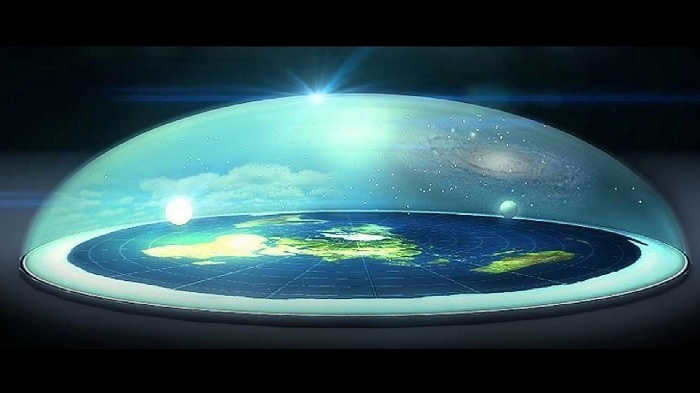
Rebuttal of the flat Earth hypothesis
In the past, individuals lacked the extensive evidence that modern scientists now possess regarding the Earth’s spherical shape. There was no explanation for why the Earth was round. However, Aristotle’s observations of the shadow cast by our planet during a lunar eclipse provide evidence against the notion of a flat Earth.
Furthermore, an additional argument against the flat Earth theory was proposed by the ancient Greek scientist. When ships appear in the distance, they emerge from the waves rather than simply becoming visible. This observation supports the idea that the Earth is not flat in form.
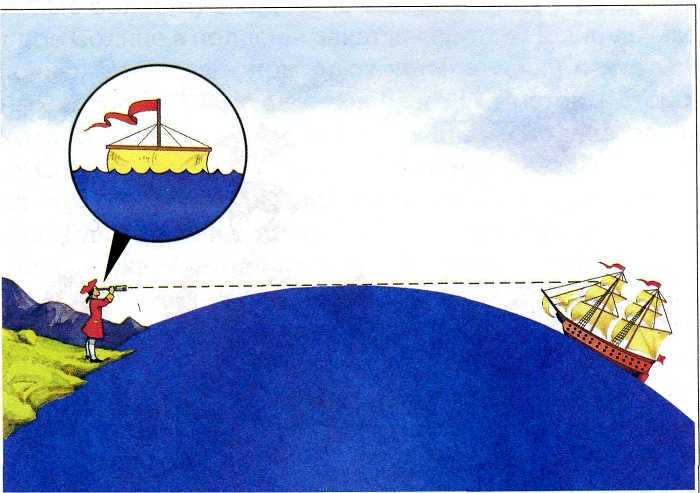
When looking at the horizon line from the ground, the view is significantly limited compared to when one ascends to a higher elevation in the same area. This phenomenon can be attributed to the Earth’s curvature.
From the vantage point of an airplane, the unevenness of the Earth’s surface becomes especially apparent along the horizon. Despite flying in a straight line for extended periods, airplanes do not encounter the edge of the planet. If the Earth were flat, such a scenario would inevitably occur.
These points effectively debunk the flat Earth theory. Scientists support the spherical shape of the Earth by presenting images taken from space as evidence, which further confirm the planet’s roundness.
What the Earth was like during its formation
The Earth formed approximately 4.54 billion years ago, along with the rest of the planets in our solar system. However, the Earth as we know it today took much longer to develop. Initially, there was no presence of oxygen on the planet. Due to its rapid rotation, the surface of the Earth became extremely hot, causing rocks to melt. The presence of water on Earth is believed to have originated from meteorites that contained ice. In the distant past, a significant number of icy meteorites bombarded our planet. Upon impact, these meteorites released water, eventually leading to the formation of the Earth’s oceans.
A globe represents a replica of our planet
The globe serves as a representation of the Earth, a three-dimensional and scaled-down version of it. In Latin, the word “globe” translates to “ball”. The globe aids in enhancing memory and visualizing the positions of continents, oceans, cities, and other geographical features.
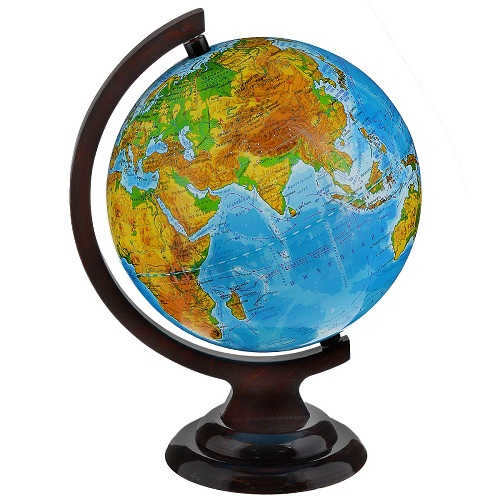
When it comes to the globe, most people don’t stop to think about its origins.
The concept of the globe dates back to ancient times, specifically the 2nd century BC. It was created by a linguist who had a deep passion for poetry. As he listened to poems, he would sketch out the routes traveled by the main characters on a map. This early globe was based on the understanding that the Earth was round, making it the first-ever representation of our planet. Unfortunately, this original globe has not survived to this day.
In 1672, Russia received its first globe of the Earth, which was specially made to order in Amsterdam and presented to the Tsar.
Thanks to the Internet, there is no need to purchase a physical globe. Instead, one can easily find a 3D model of the Earth on various websites by simply searching for “3d model of the Earth” using a search engine.
This model is a three-dimensional representation of an object.
Upon searching, a blue ball representing the globe will immediately appear on the computer screen. The model can be interacted with by rotating it and zooming in using the mouse wheel. Users can explore different countries, cities, and even streets with houses. The 3D globe of the Earth provides a modern and cost-effective way to experience the captivating and mesmerizing view of our planet as seen from space.
The Earth is represented by a three-dimensional model known as the globe, with various colors indicating different features of its surface. For instance, dark brown represents high mountains, blue represents deep seas, green represents plains, and yellow represents deserts, among others.
It is possible to create models of the Earth’s surface on your own. To do this, you can start with a pre-made globe or ball and add the contours of continents, mountains, and other landforms. Once you have added these features, you can use multicolored plasticine to mold them, paint them with different colors, and then glue them onto the globe. This will result in a three-dimensional model that makes it easy to study the Earth’s surface.
Rotation of the Earth
The Earth is a remarkable celestial body. It undergoes rotation on its axis while also orbiting around the Sun. Within a span of approximately 24 hours, the planet completes a full rotation at a velocity of 1674 km/hour along the equator. However, at the Earth’s poles, the rotational speed is virtually negligible.
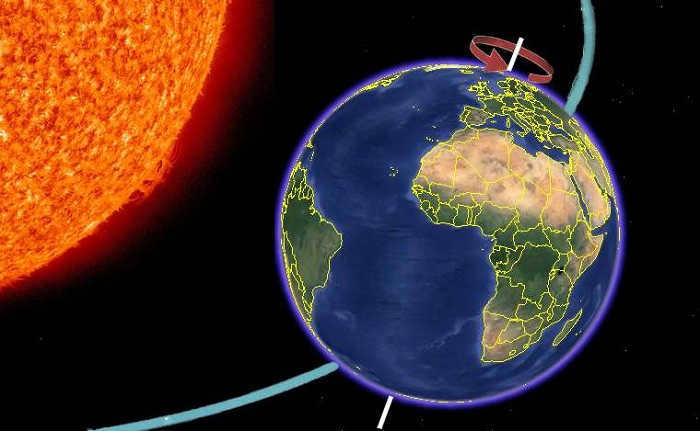
Planet Earth orbits the Sun at a velocity of 108,000 kilometers per hour, with the Earth completing one revolution around the star in 365 days, which equates to a year.
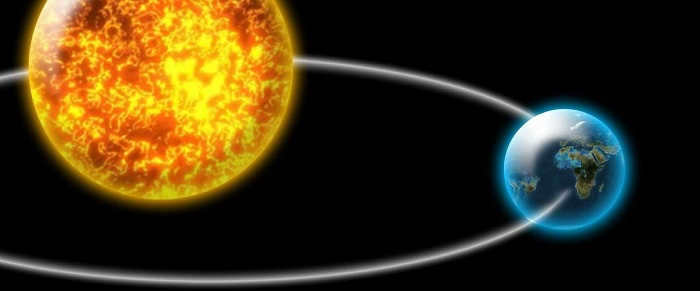
The reason why the Earth rotates can be explained by considering its origin. The planet formed from a disk of gas and dust that accumulated. This disk revolved around the Sun, occasionally colliding with space rocks. These collisions led to the Earth spinning due to the impact. As a result, all the debris and the Earth began rotating in the same direction around the Sun. This is what causes the Earth to rotate. Since then, our planet has continued to spin ceaselessly.
The Earth rotates on an axis within the solar system. The axis of rotation is an imaginary straight line that passes through the center of the planet and intersects it at the poles.
Is it possible to see the Earth’s axis of rotation?
No, the axis cannot be seen as it is a conceptual line and does not have a physical existence.
The rotation of the Earth on its axis causes a transition between day and night, preventing extreme temperatures and allowing for a diurnal rhythm in the lives of organisms, including humans.
Confirmation of Earth’s rotation through the pendulum experiment
In 1851, the French physicist and astronomer Foucault conducted a public experiment using a pendulum, which provided evidence of the Earth’s rotation.
A heavy metal ball was suspended from a large dome by a wire, allowing it to swing in various directions. A sharp tip was attached to the end of the pendulum, while sand was placed at the bottom to leave a trace as it crossed the sandy path.
With each swing of the pendulum, it strayed from its previous path etched into the sand. After two hours of the experiment, it became apparent that the pendulum was rotating in a clockwise direction in relation to the floor. It was discovered that in approximately 32 hours, the pendulum completed a full revolution and returned to its original position. The onlookers were astounded. Although they couldn’t physically feel the Earth’s rotation, they were presented with visual evidence that the planet is indeed spinning.
Another indication of the Earth’s rotation can be observed when objects fall. Rather than dropping in a straight line, they veer slightly to the east.
Our planet is one of a kind. It consists of 80% water and just 20% land. The watery part is known as the world’s oceans, which encompass all the seas, rivers, lakes, and other bodies of water. Life exists on Earth due to the presence of air in the atmosphere. The planet’s rotation on its axis leads to the alternation of day and night. Meanwhile, its orbit around the Sun brings about the changing of seasons.
Moreover, our planet has a natural satellite called the Moon.
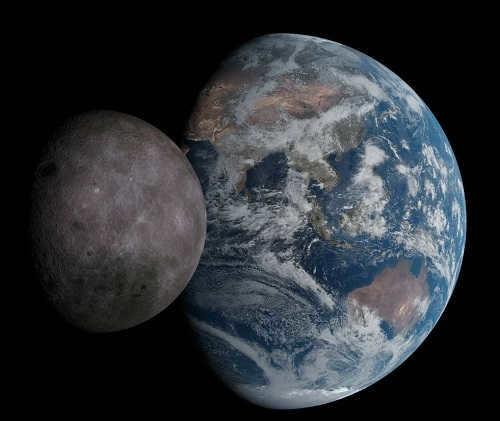
Although devoid of life, humans have successfully visited the Moon. One fascinating aspect of the moon is its ability to influence the tides in our oceans, a phenomenon attributed to its magnetic field. Additionally, the moon undergoes rotation on its axis, yet only one side perpetually faces the Earth.
The night sky is adorned with an astonishing multitude of billions of stars. While the human eye can only perceive a fraction of this dazzling celestial display, the stars are undeniably present. Despite the advanced tools at our disposal, scientists are unable to ascertain the exact number of galaxies in the observable universe. However, even a rough estimate is mind-boggling, with over 150 billion galaxies believed to exist. Within one of these galaxies lies our cherished solar system, home to Earth and its inhabitants.

Where exactly is the planet Earth situated in the galaxy?
The planet Earth is located within a galaxy, which is an immense cosmic system comprised of numerous stars and star clusters. Alongside these, galaxies also encompass gas-dust clouds and nebulae, neutron stars, black holes, white dwarfs, and dark matter – an unseen and unexplored element that constitutes 70% of the entire mass of the universe.
Gravitational forces unite all entities and keep them perpetually in motion around a shared focal point. A prevailing belief, bolstered by recent scientific investigations, posits that supermassive black holes reside at the heart of many, if not all, galaxies. In light of the theory of the universe’s expansion, scientists have deduced that the substance which coalesced into galaxies over 12 billion years ago consisted of gas-dust nebulae.
Galaxies Categorization
Currently, there are three main categories of galaxies: spiral or disk galaxies, elliptical galaxies, and irregular or unstructured galaxies. Spiral galaxies are the most prevalent type, characterized by their flat disk shape with one or more arms curving around the central region. These galaxies contain stars of various ages, with the spiral arms displaying a blue hue due to the abundance of young stars. Some spiral galaxies feature a stellar bulge at the center, serving as the starting point for the spiral arms.
Elliptical galaxies, on the other hand, predominantly emit a red-orange spectrum of light as they consist mostly of older stars. Their shape can range from nearly spherical to slightly flattened. In these galaxies, the stars are densely packed around a central core.
Another theory suggests that some of the irregular systems may still be in their early stages of development, and as a result, their galactic structures have not yet fully formed.
The Milky Way
The solar system, including all of its planets, is part of the Milky Way galaxy. It was the first galaxy ever discovered by humans. From any location on Earth’s surface, the Milky Way can be seen as a faint smoky band. Scientists estimate that it contains between 200 and 400 billion stars.
The Milky Way is classified as a spiral galaxy. If we were able to observe it from outside, we would see a relatively thin disk, only a few thousand light-years thick, with a diameter of over 100,000 light-years. The majority of stars are concentrated within this central disk-shaped region of the galaxy.
The galactic core contains a vast number of aging stars, forming the central part of the system. Recent findings suggest that within this core lies a supermassive black hole, and there may even be multiple black holes present. Surrounding the central region is a gas ring, which serves as an active zone for the birth of new stars.
Around 50 years ago, scientists made the discovery that the Milky Way possesses four primary spiral arms that extend from the gas ring. These arms are areas of high density where new stars continue to form. More recently, another arm has been identified, located far from the central region. The speed at which stars travel in their galactic orbits differs from that of the spiral arms, gradually decreasing as they move away from the system’s center.
The Sun is situated 28,000 light-years away from the galactic center. It completes a full revolution around this central region every 250 million years.
The Earth is one of the celestial bodies orbiting the Sun in the Solar System. It is situated in the vast expanse of the Universe, which is composed of countless galaxies. The particular galaxy that encompasses our planet is known as the Milky Way. When gazing at the night sky, one can observe a luminous band resembling a river of spilled milk. This luminous band is none other than the Milky Way.
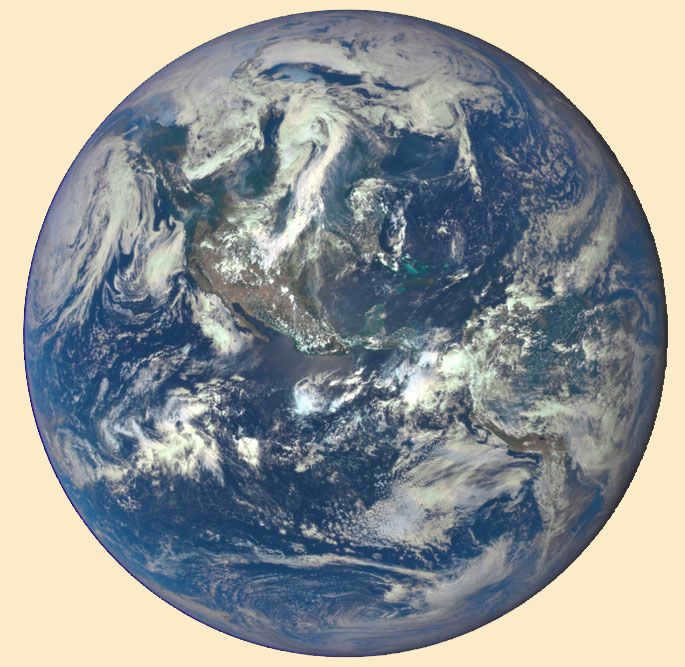
The Position of Earth in the Galactic System
The galactic system consists of a total of eight planets, each possessing its own distinct characteristics and structure. However, they are all connected by the fact that they rotate precisely within their respective orbits. Each planet follows its own unique path in orbit. Within the galaxy, there are countless stars, with the Sun serving as one of them. It is this massive star around which the planets of the galactic system revolve. The arrangement of the solar system’s planets in relation to the Sun is as follows (in order of distance):
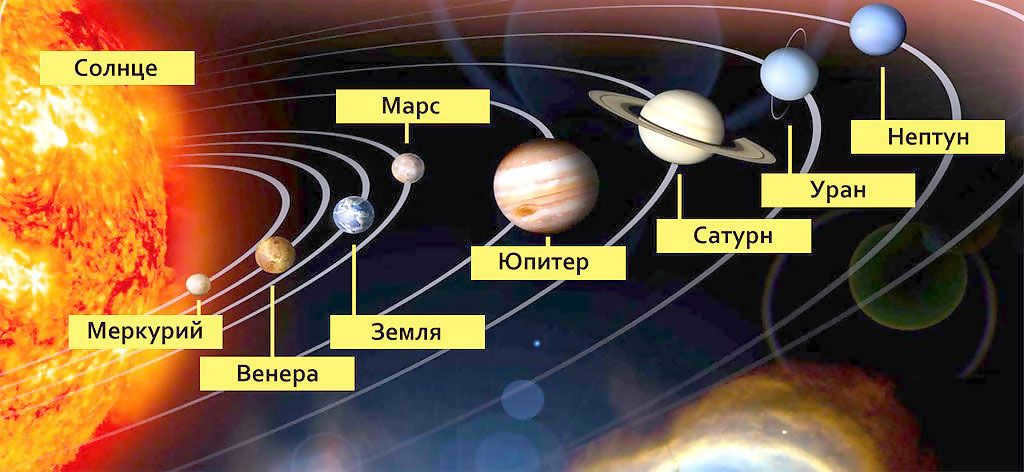
- Mercury – the first planet from the sun
- Venus – it is notable for its slower rotation around the axis compared to other planets.
- Earth – A planet with abundant life
- Mars – often referred to as the red planet.
- Jupiter – is the largest planet in our solar system and has the most satellites.
- Saturn – is famous for its ring system that encircles the planet.
- Uranus – known as the “tilted planet” due to its unique perpendicular orbit.
- Neptune – is the farthest planet from the Sun, resulting in the longest rotation period.
In our Solar System, there exist a number of dwarf planets such as Ceres, Haumea, Makemake, and Erida.
| Mercury | 4,879 | 0.24 | 57.9 |
| Venus | 12,104 | 0.62 | 108.2 |
| Earth | 12,756 | 1 | 149.6 |
| Mars | 6,792 | 1.88 | 227.9 |
| Jupiter | 142,986 | 11.86 | 778.6 |
| Saturn | 120,536 | 29.46 | 1434 |
| Uranus | 51,118 | 84.32 | 2877 |
| Neptune | 49,528 | 164.79 | 4503 |
There are only 8 planets in our Galaxy that are the largest objects. Apart from these planets, there are more than 60 satellites, over 5 thousand asteroids, and various other objects. One thing that all these objects have in common, including cosmic dust, is that they all have gravity, which determines their position in the solar system relative to the Sun. The paths of these objects rarely intersect with each other. Additionally, each object follows an orbit, which is mostly in the shape of an elongated circle. Our planet, Earth, exhibits all of these characteristics as well. It also rotates on its axis and completes a full revolution in 1 calendar year, equivalent to 365 days, 5 hours, and 48 minutes in cosmic terms. The Earth has a satellite, the Moon. The distance from the Earth to the Sun is approximately 150 million kilometers, while the distance from the Earth to the Moon is approximately 384,400 kilometers.
Earth and the Moon
The Earth and the Moon are two celestial bodies that are closely linked. They have a unique relationship that has fascinated scientists and researchers for centuries. The Earth is the third planet from the Sun, while the Moon is Earth’s only natural satellite.
The Earth is a vibrant and diverse planet that supports a wide range of life forms. It has a rich atmosphere that provides the perfect conditions for life to thrive. The Moon, on the other hand, is a barren and desolate place with no atmosphere or water. It is covered in craters and has a rugged landscape.
Despite their differences, the Earth and the Moon have a strong gravitational bond. The Moon’s gravity causes tides on Earth and also helps stabilize its axial tilt, which is responsible for the planet’s seasons. The Moon’s gravity also affects the Earth’s rotation, slowing it down over time.
The Moon’s proximity to Earth has made it a subject of fascination for humans throughout history. It has been the inspiration for countless myths, legends, and scientific studies. Humans have even set foot on the Moon, with the Apollo missions in the 1960s and 1970s.
In conclusion, the Earth and the Moon are a unique pair in the solar system. They have a symbiotic relationship that affects many aspects of life on Earth. The Moon’s influence on Earth’s tides, seasons, and rotation makes it a fascinating object of study and exploration.
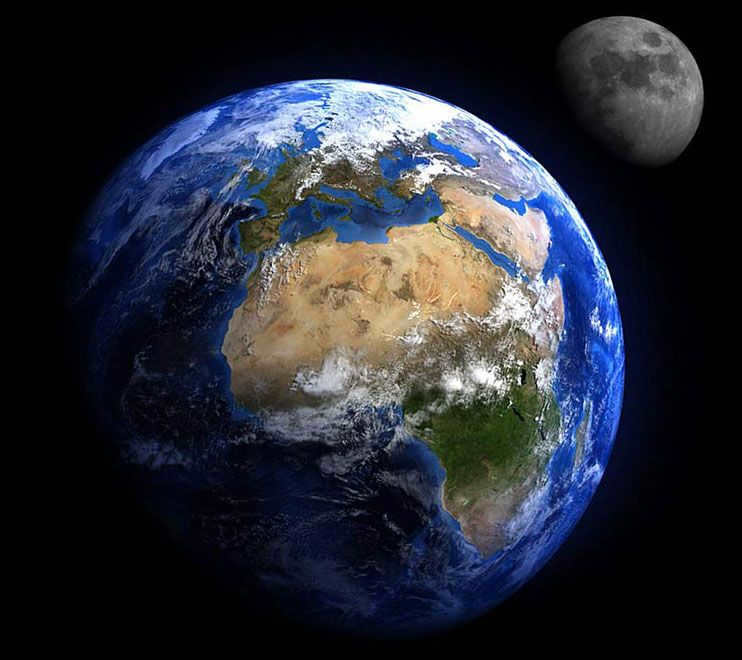
The Earth is located in a system where the planet is orbited by the Moon. This natural satellite is approximately 384,400 kilometers away from our planet. While the Moon rotates on its own axis, it does not orbit around the Sun like the Earth does. Instead, it revolves around the Earth. As a result, we only see one side of the Moon from Earth. This gives the Moon the appearance of glowing and emitting light at night. However, in reality, the Moon does not actually glow itself. It simply reflects the light from the Sun. It is this reflected light that creates the illusion of the Moon glowing when observed from Earth.
There exists a connection between the Earth and the Moon that is demonstrated through their mutual attraction. Primarily, this connection is evident in the realm of water. Occurrences such as tides are directly linked to the gravitational pull and the movements of the Moon. The correlation between tides and the Moon’s activity was first observed in ancient Greece. The Moon’s gravitational force is so substantial that it causes the Earth’s oceans to form currents and distort under pressure. As the Moon orbits around the Earth, it generates a tidal wave that traverses the world’s oceans. As it recedes, the water follows suit. If we consider the laws governing the cosmos, the Sun should theoretically exert a similar influence on water. However, due to its great distance from the Earth, it lacks the same powerful impact on tides.

Structure of the Planet
The planet Earth possesses a spherical form, often referred to by scientists as a geoid. The Earth’s total area spans 510 million square kilometers. A significant portion of this surface is enveloped by a water layer, with the largest part being the Pacific Ocean. Above the water lie the landmasses constituting the six continents: North America, South America, Antarctica, Australia, Africa, and Eurasia.
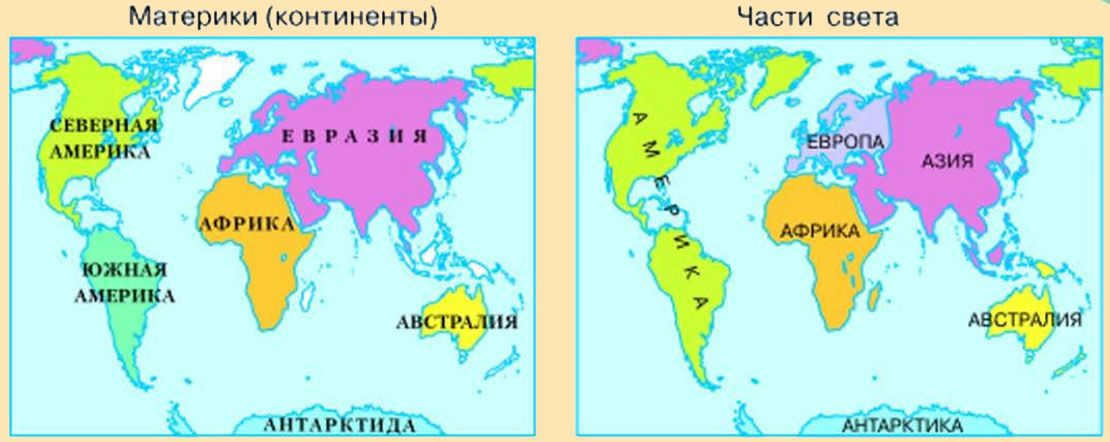
If we consider the regions of the world, there are also six of them, but they differ slightly from the continents. The regions of the world on Earth are America, Antarctica, Africa, Australia, Europe, and Asia.
For instance, Russia is situated on the Eurasian continent but geographically belongs to two regions of the world: Europe and Asia.
There are four primary spheres on Earth:
- The lithosphere – a solid shell (comprising the entire Earth’s crust and everything below it).
- The hydrosphere – a water shell. It encompasses all conceivable water bodies.
- The atmosphere – the air envelope. It begins from the lithosphere and gradually extends into space.
- The biosphere – the designated shell where all living organisms on Earth reside.
The combination of all four shells creates a distinct geological structure that defines planet Earth. The intricate characteristics of each shell contribute to the existence of life on our planet. This is what sets Earth apart as a celestial body within the solar system.
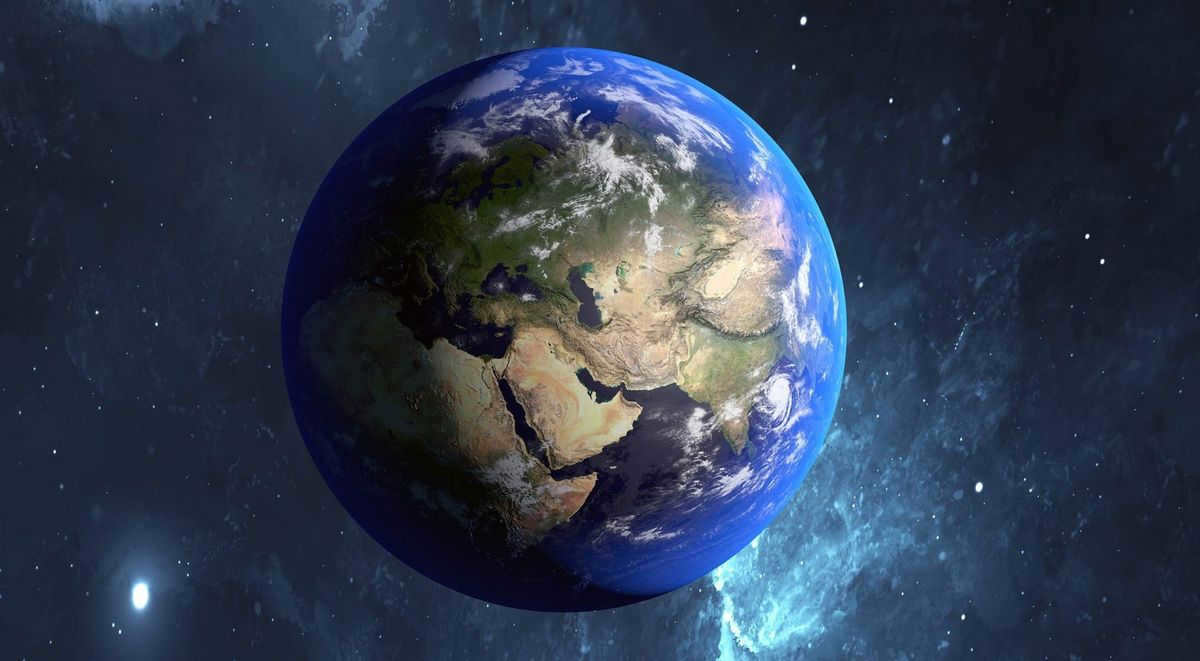
What is the designation of our planet? The Earth is positioned as the third celestial body in the solar system and holds the distinction of being the largest in its group. It is characterized by its remarkable density. While the other planets were assigned names based on mythological deities, the Earth stands out as an anomaly. Our planet, known as Earth, is commonly referred to as “fertile,” signifying its rich soil and agricultural potential. This article will delve further into the formation of planet Earth, offering valuable insights for both children and adults.
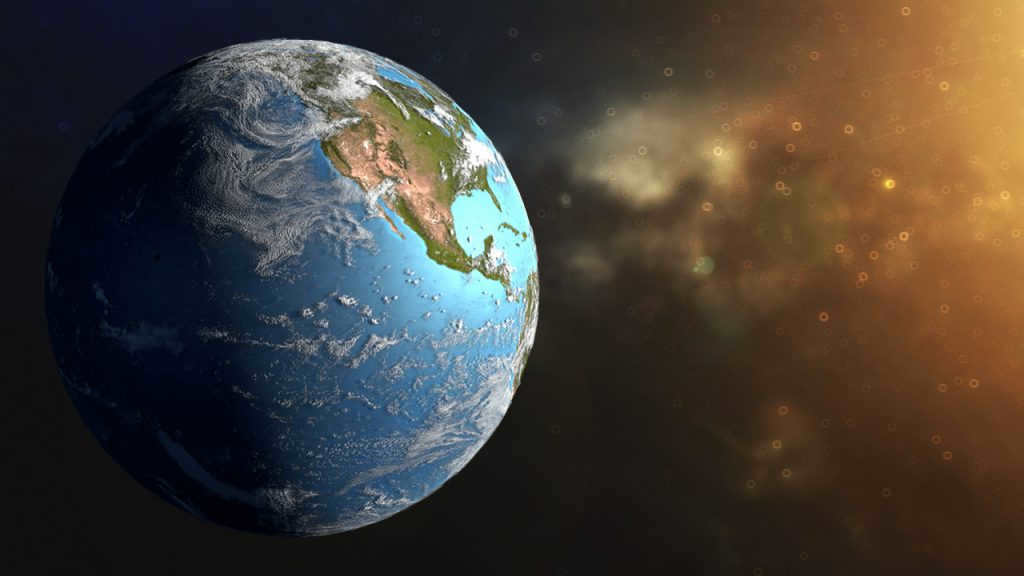
Overview
Here is a concise overview of our planet, Earth, that may be beneficial for students.
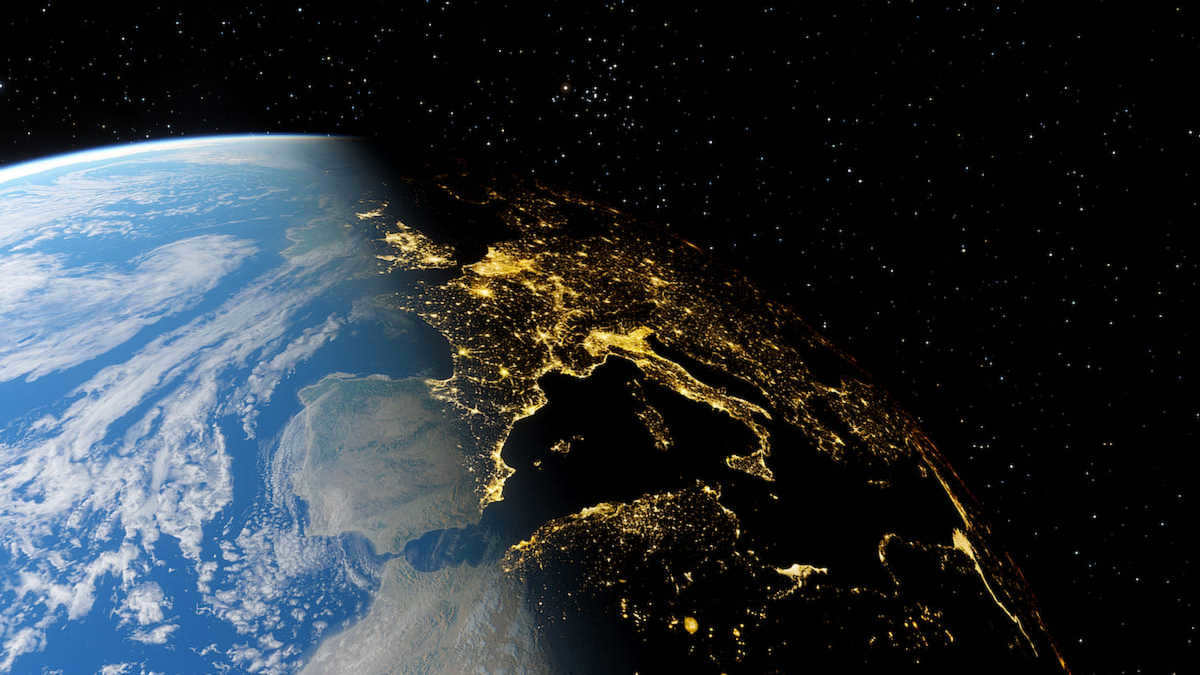
Even though the Earth has been extensively researched, there are still some enigmas that remain unsolved.
When it comes to the grand scheme of the universe, our planet is considered relatively small, weighing in at only 5.9×1024 kg.
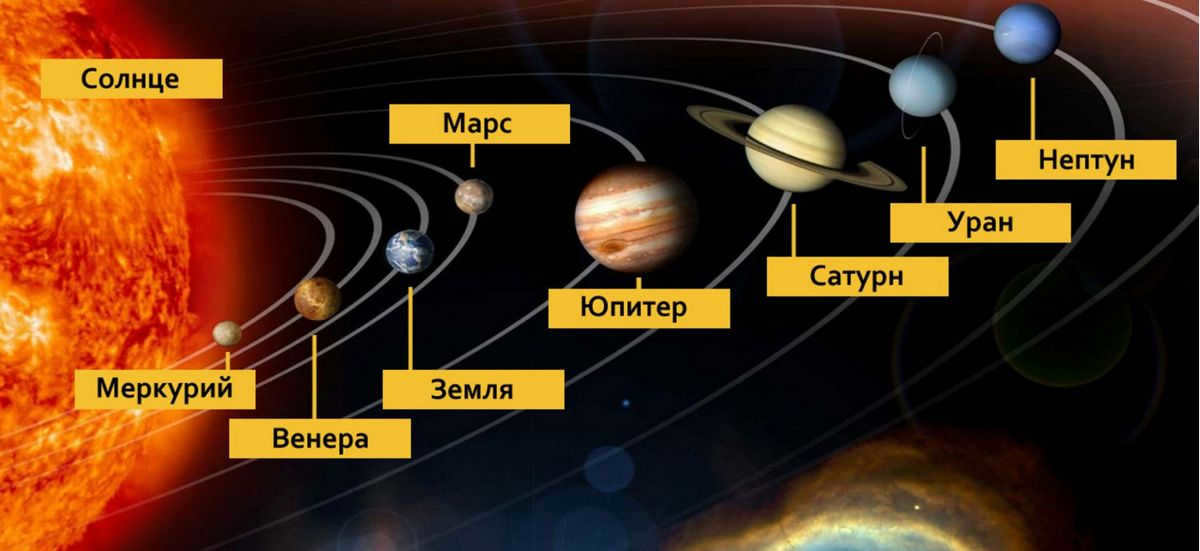
What is the appearance of our Earth and what is its form? Visually, it appears to have a spherical shape. However, this is not the case.
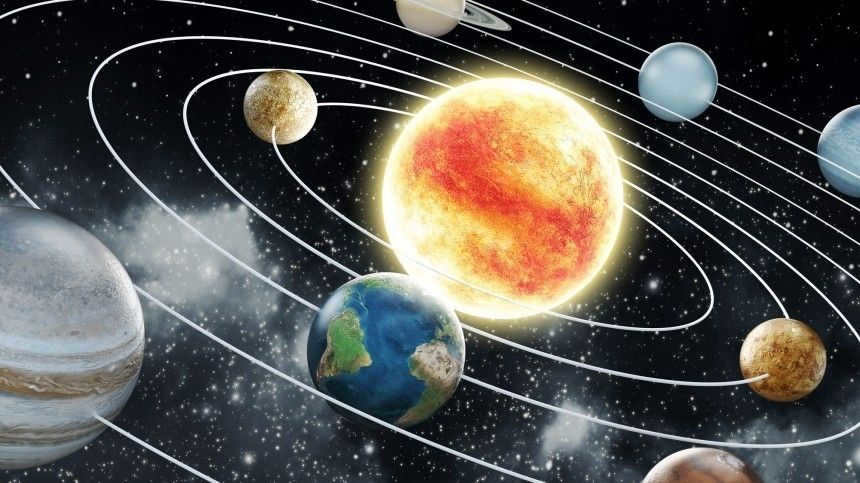
The Earth is not a perfect sphere. It has a radius of approximately 6,300 kilometers. The equatorial radius, on the other hand, measures about 6,378,000 kilometers while the polar radius is around 6,356,000 kilometers. The planet’s diameter along the equator is about 40,075 kilometers, and along the meridian it is approximately 40,007 kilometers. The volume of Earth is estimated to be around 10.8×1011 cubic kilometers.
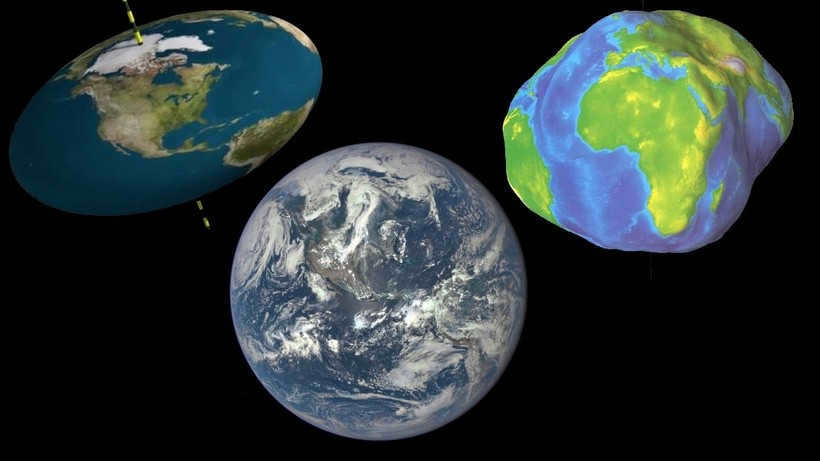
It is a well-known fact that the planet Earth revolves around the Sun. This revolution occurs along the orbit that was established during the formation of the solar system.
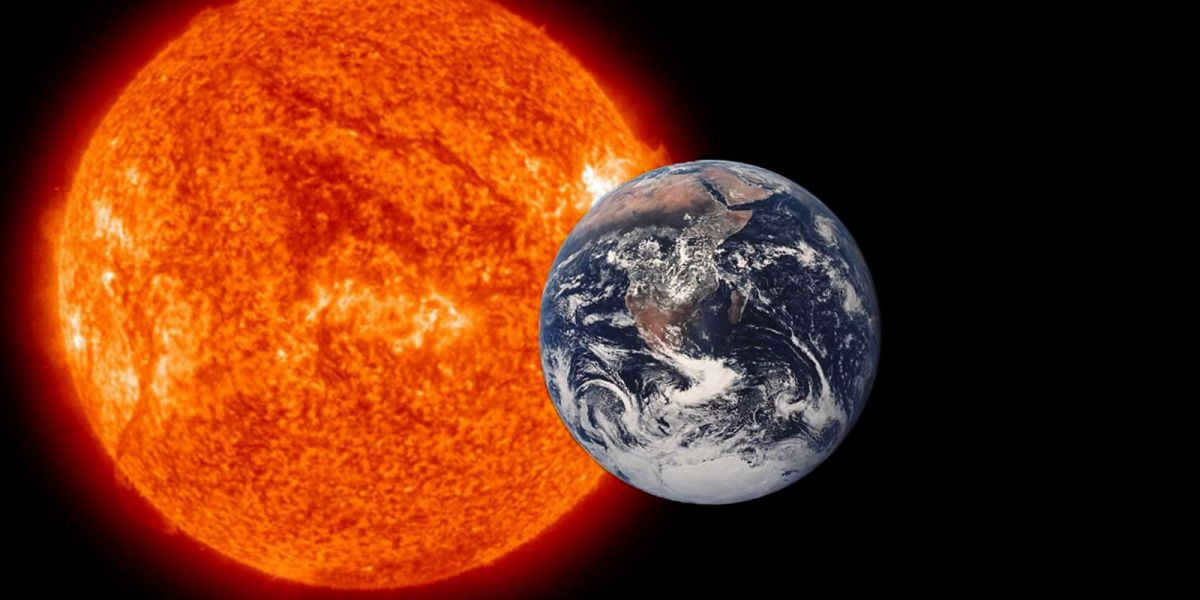
During the winter season, we are 2.5 million kilometers nearer to the Sun compared to the summer months. On an average, the distance between the Earth’s center and the Sun is 149.5 million km. The Earth rotates in an eastward direction.
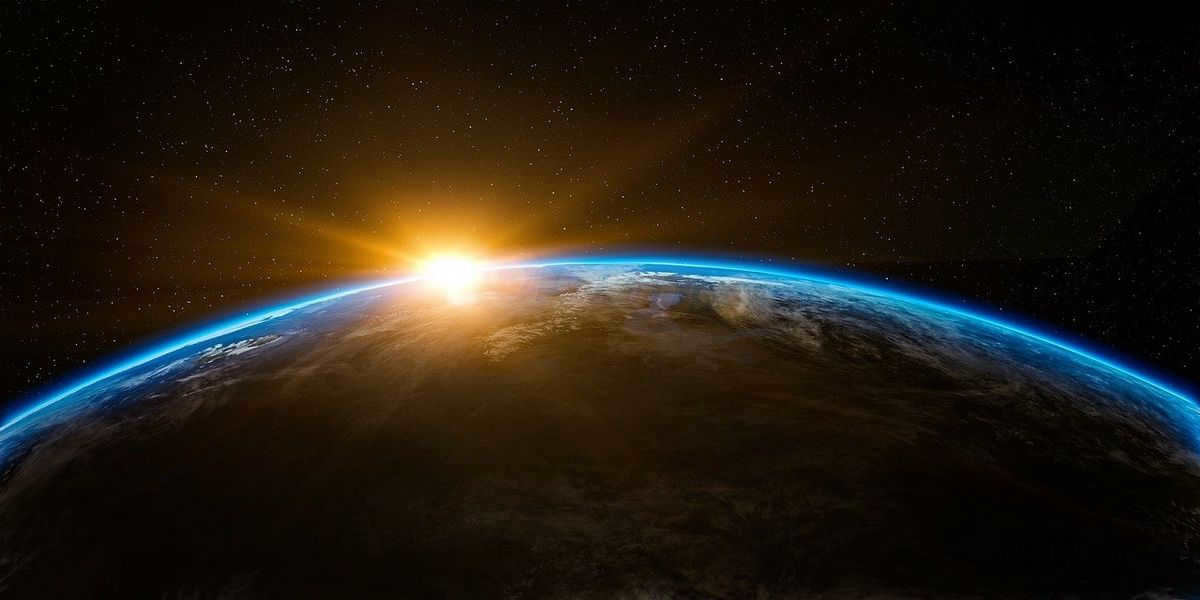
Diagram of the Earth’s orbit around the Sun:
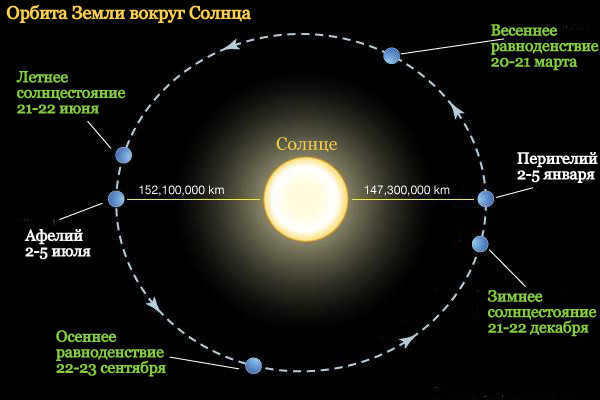
The planet Earth is positioned within a system where its axis is inclined at an angle of 66 degrees. Additionally, the equator itself is tilted at an angle of 23 degrees relative to the rotational axis of the Earth.
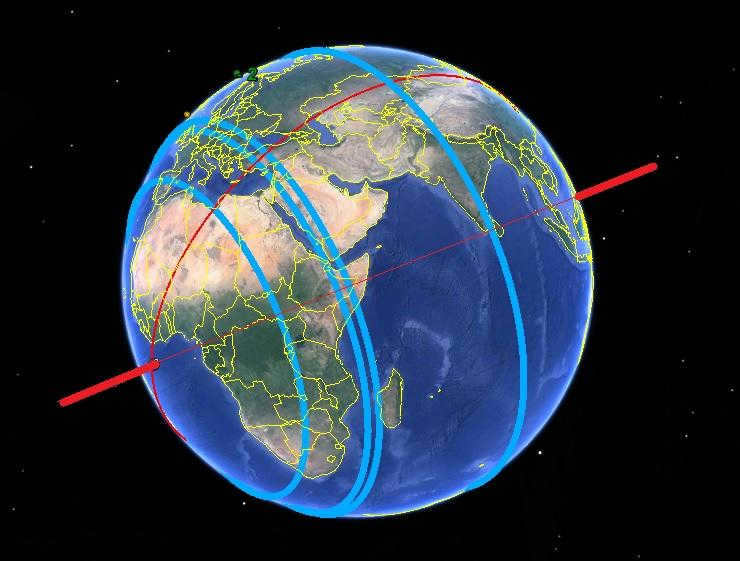
The planet Earth is located in a system where its axis can undergo a change known as precession. This phenomenon is caused by the gravitational forces exerted by the Earth’s natural satellite and the center of the system.
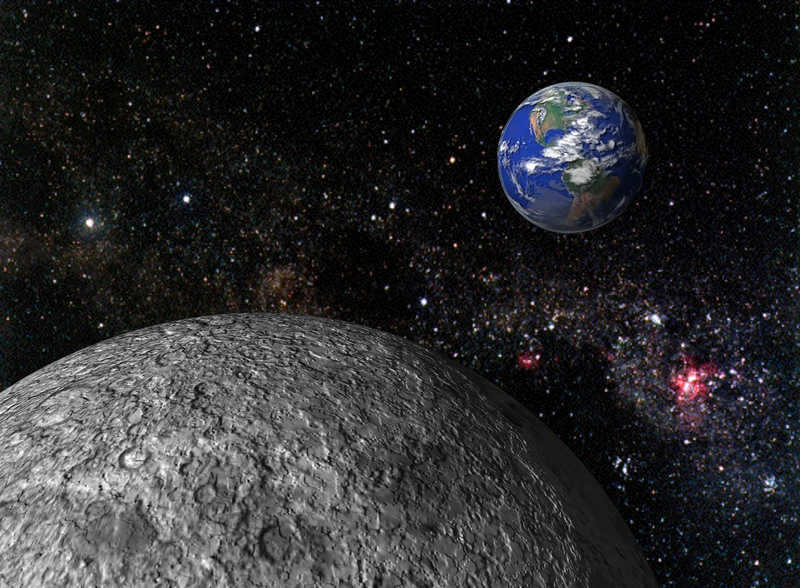
The precession has a duration of 26,000 years. The Earth’s orbital motion around the galactic center (Milky Way) has a duration of 235 million years.
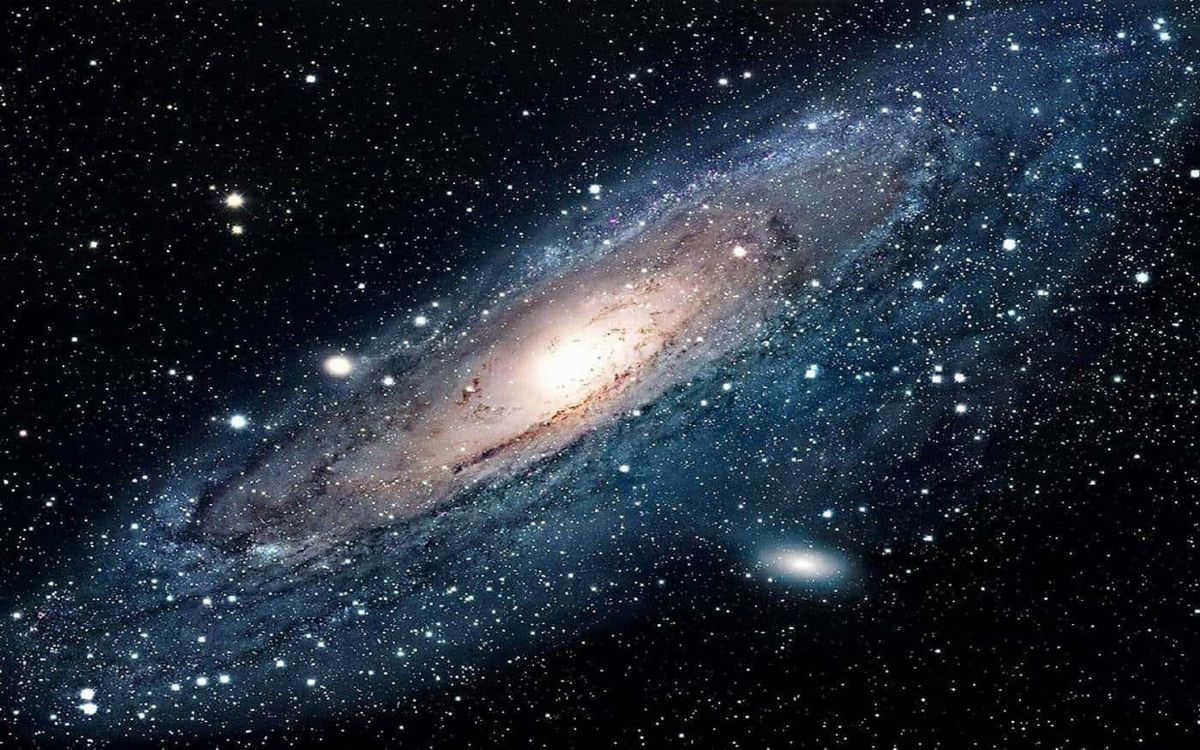
The planet Earth is situated in a specific system known as the Solar System. It has an average density of 5.5 grams per cubic centimeter. The density of its interior is constantly undergoing changes.
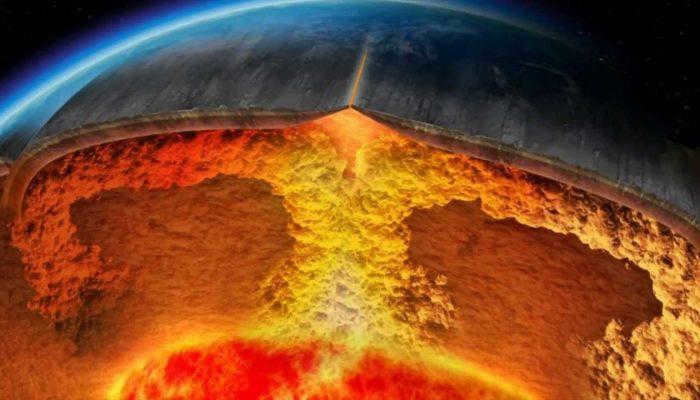
When it comes to computations, the measurements of the oscillation duration, the momentum of inertia, and the momentum of impulse are utilized.
The vast majority of the Earth’s surface is covered by water, accounting for over 70%.
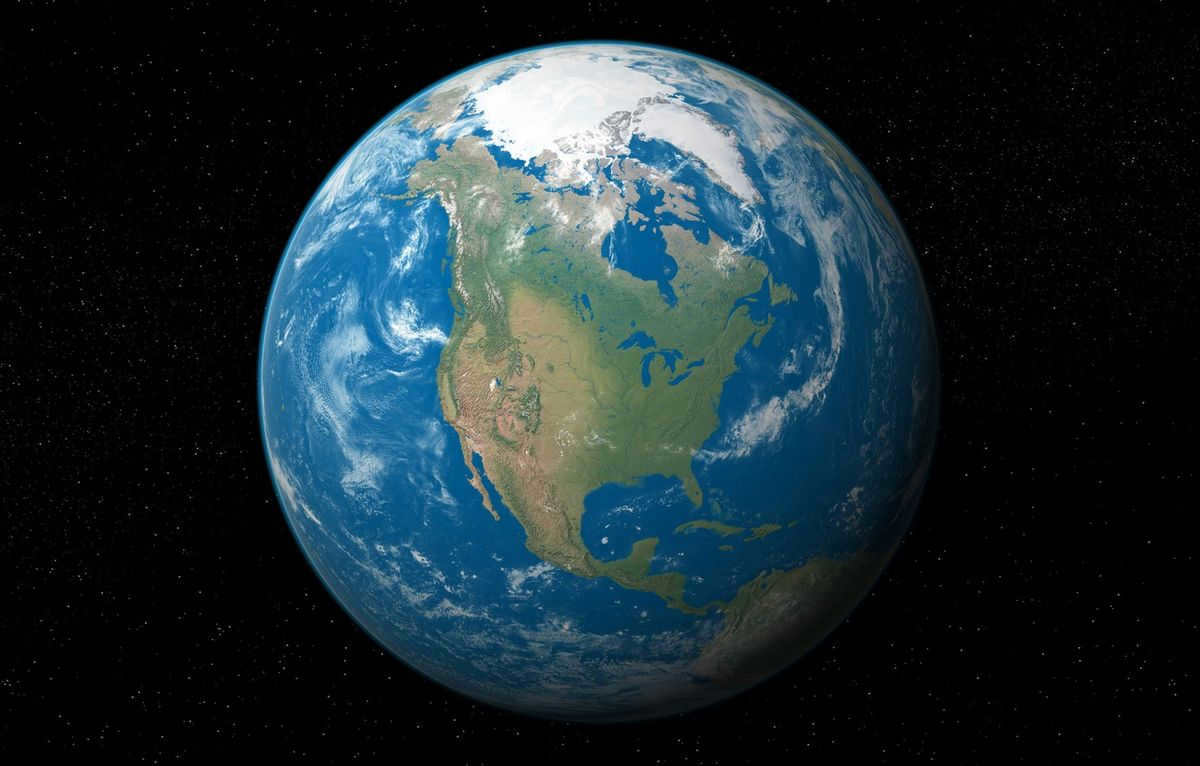
The rest consists of archipelagos and landmasses. The rate of gravitational acceleration measures 81 meters per square centimeter.

Silicate and iron are regarded as the primary components of the Earth’s surface. The Earth’s natural satellite is known as the Moon.
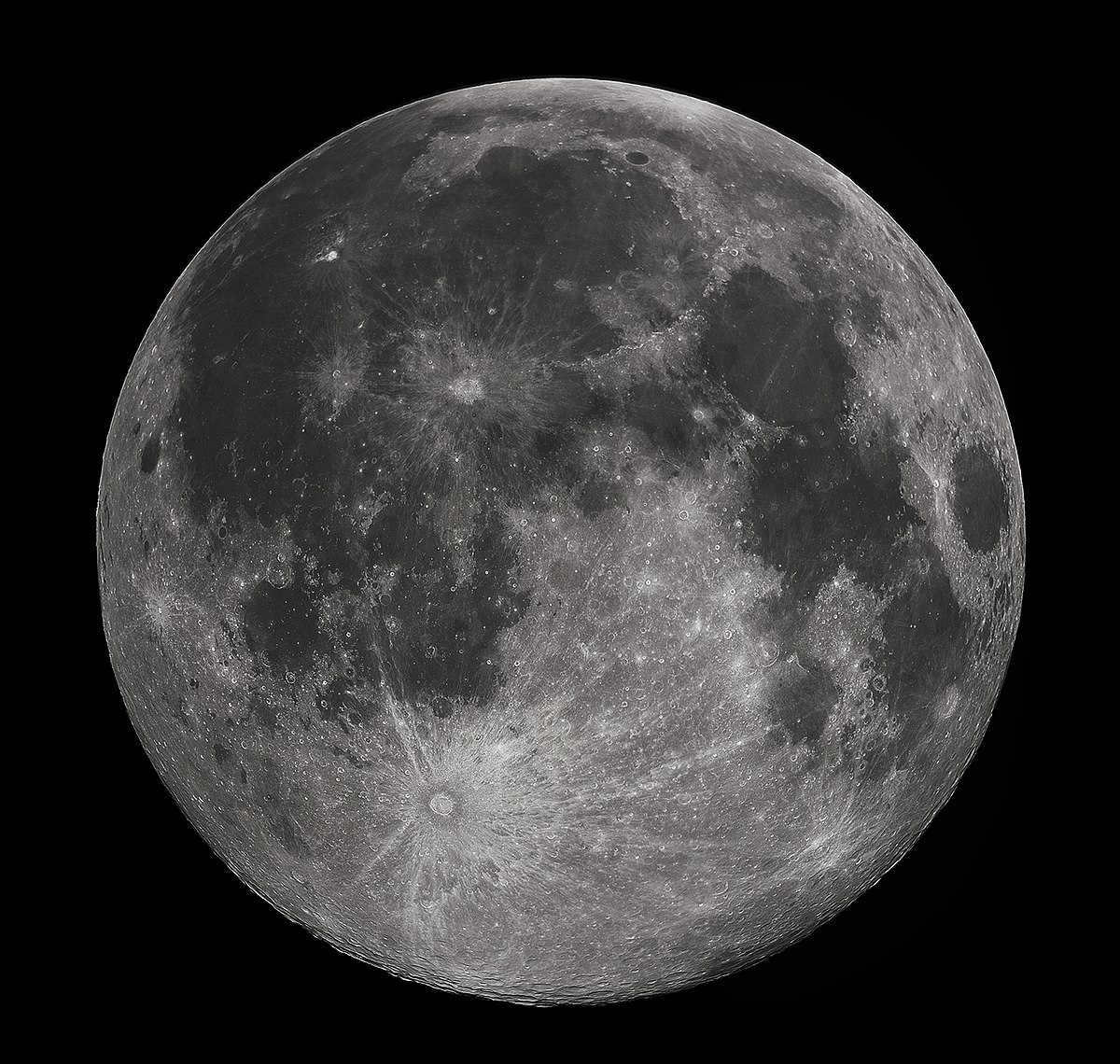
Nevertheless, there have been findings of additional spacecraft, albeit man-made in origin.
Origins of Our Planet
The Earth is estimated to be approximately 4.6 billion years old. Its formation can be attributed to the accumulation of mass from celestial objects through the gravitational pull of planetesimals.
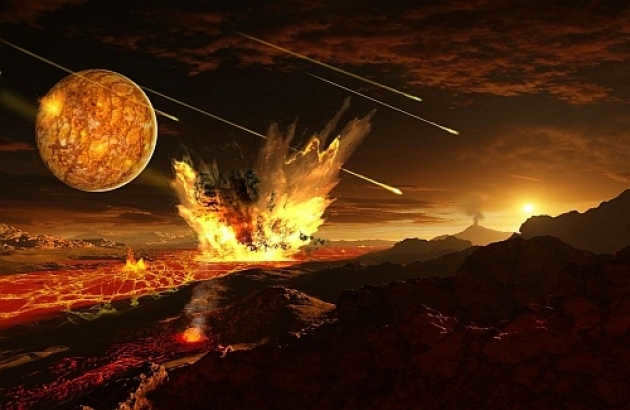
In a system where the planet Earth is located, there exist tiny particles that originated and merged within a cloud composed of dust and gases. These particles are currently gravitationally attracting each other at a hastened pace.
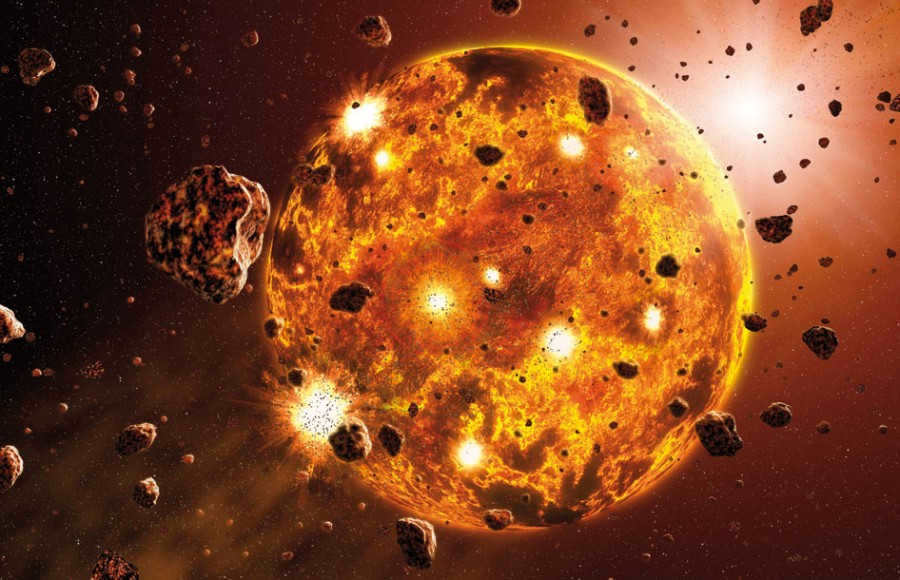
Within a mere 17 million years, the Earth accumulated the same mass as Mars has today.
It then required an additional 100 million years for the Earth to reach its present weight.
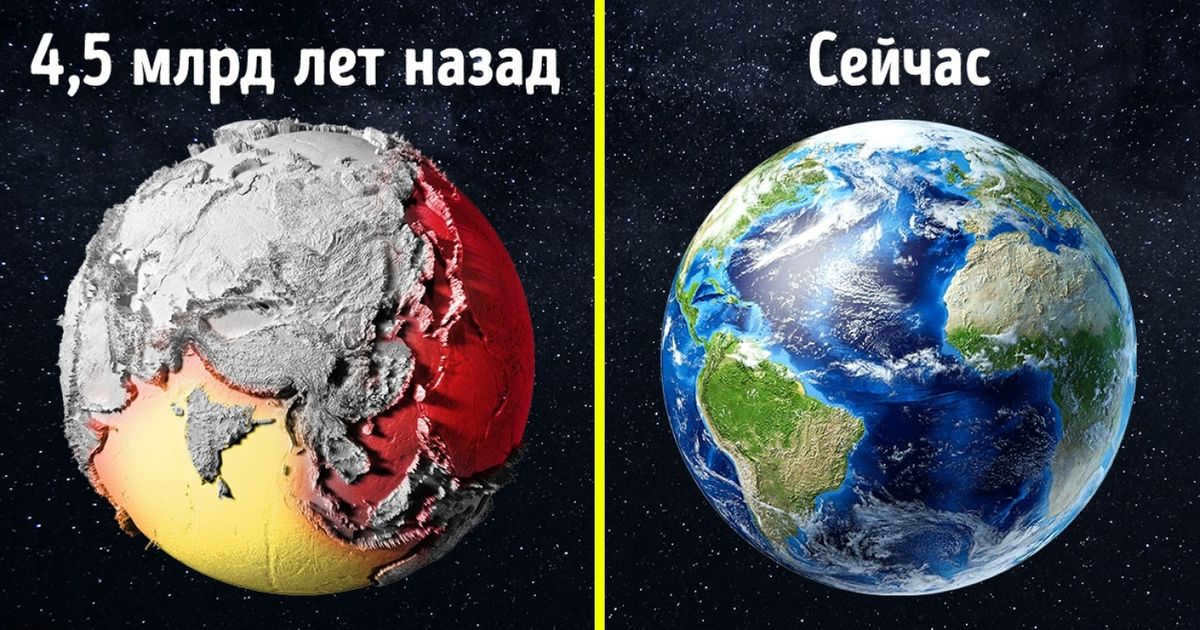
Due to frequent volcanic eruptions and numerous collisions with celestial objects, the planet was ablaze. Subsequently, the outer layers cooled, enabling the formation of Earth’s crust.
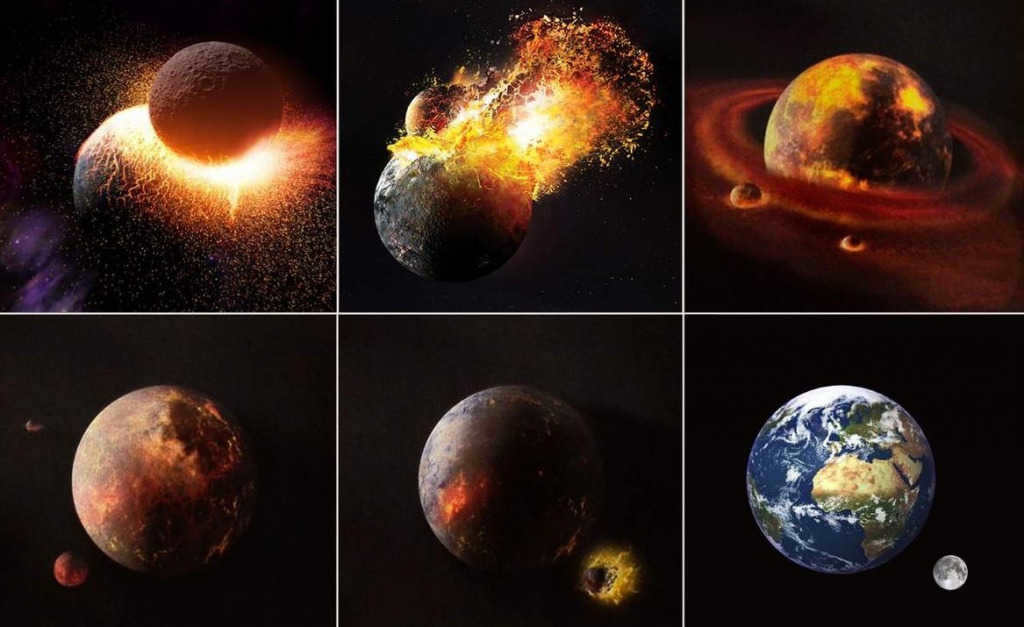
The Earth’s atmosphere was formed as a result of volcanic activity and degassing. According to scientists, the ice that eventually turned into water arrived on Earth through collisions with comets.
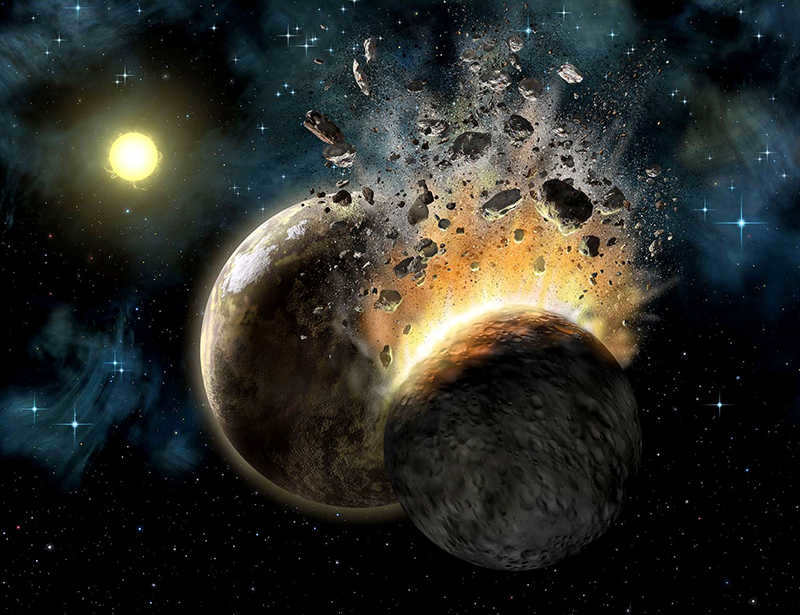
The Earth’s surface underwent transformations for a duration of 100 to 200 million years. The formation and breakup of continents occurred in a repetitive manner.
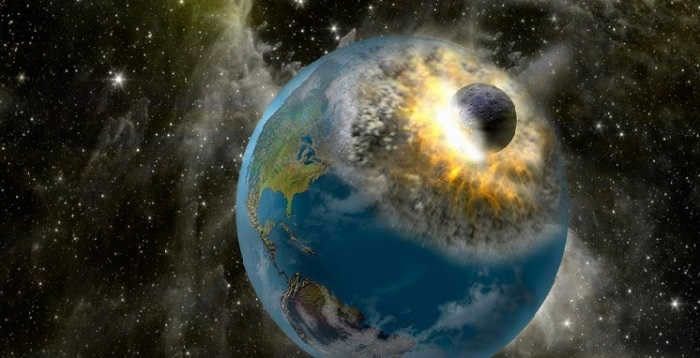
Around 750 million years ago, the supercontinent known as Rodinia began to separate. After another 500 million years, a new supercontinent called Pannotia formed, and eventually gave way to the formation of Pangaea.
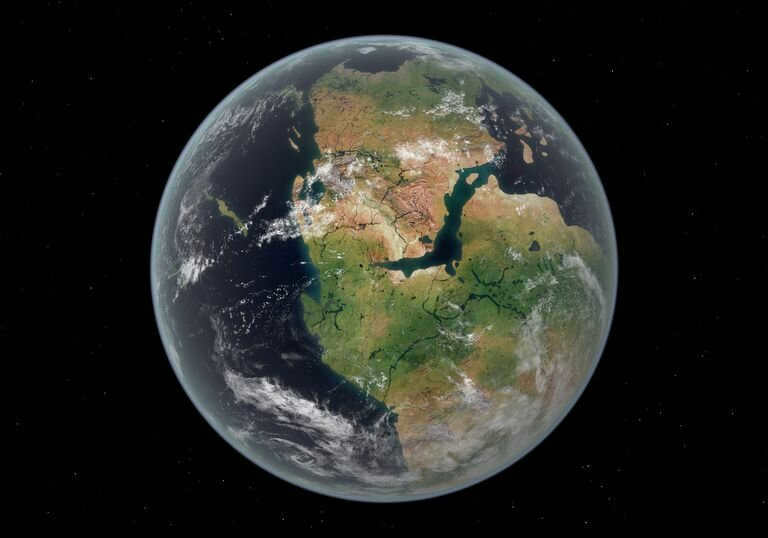
The latter crumbled nearly 200 million years ago. It is worth mentioning that all of the aforementioned figures are estimated. Indeed, determining the precise age of the planet is an extremely challenging task.
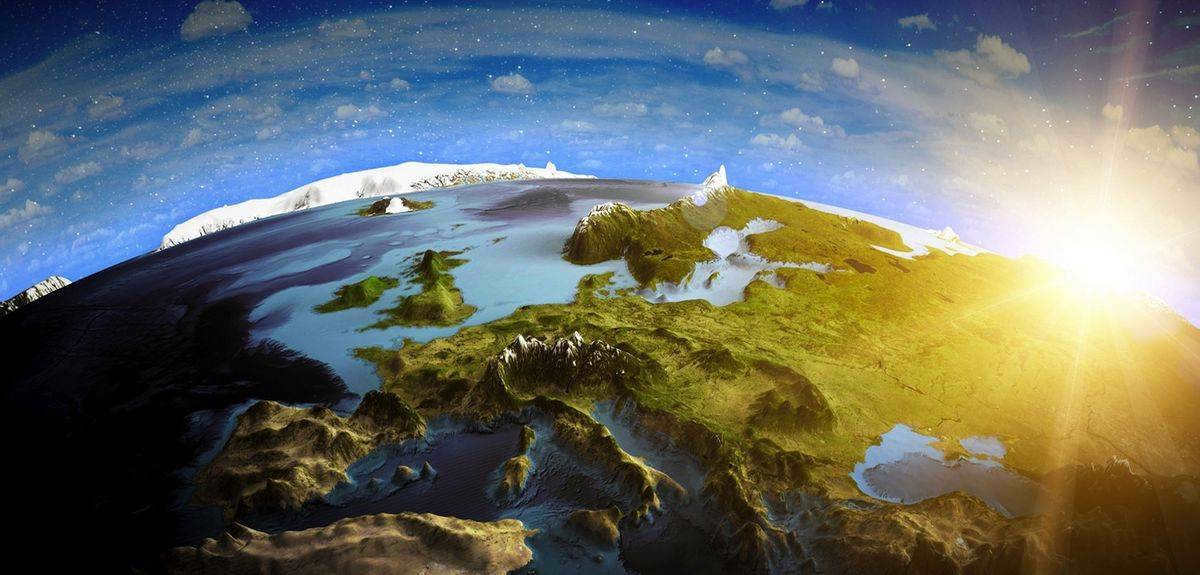
Observation Findings
The planet Earth was captured on camera for the very first time in the late 1950s using the sixth version of the “Explorer” device.

Yuri Gagarin became the first individual to lay eyes on the planet. In the late 1960s, individuals aboard the “Apollo-8” spacecraft beheld the Earth from the lunar orbit.
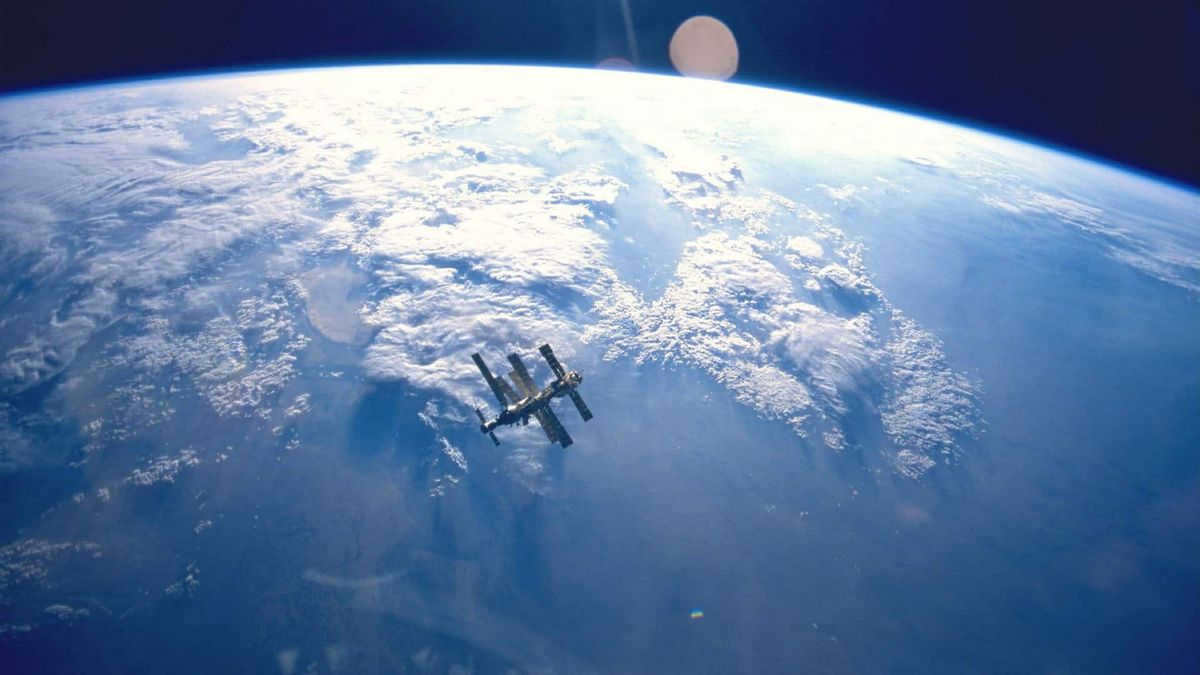
The crew of Apollo 17 didn’t capture images of the planet from lunar orbit until 1972.
Form and inner composition
What materials constitute the planet? The arrangement is unbalanced and it is assumed that the Earth has a spherical shape.
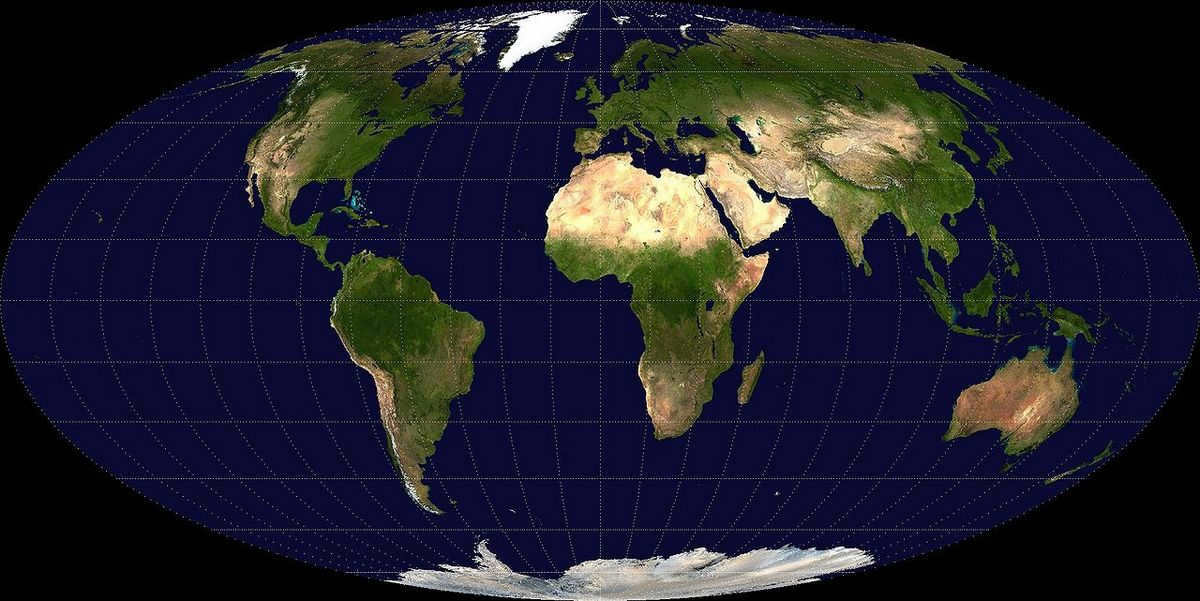
Depressions have been discovered on the planet’s surface. It has been established that the Earth has a pear-shaped protrusion. Consequently, it has been determined that the Earth has a triaxial ellipsoidal shape. The distribution of weight on the surface is not uniform.
This uneven distribution can be attributed to the presence of continents and oceans, both on the Earth’s surface and within its inner layers.
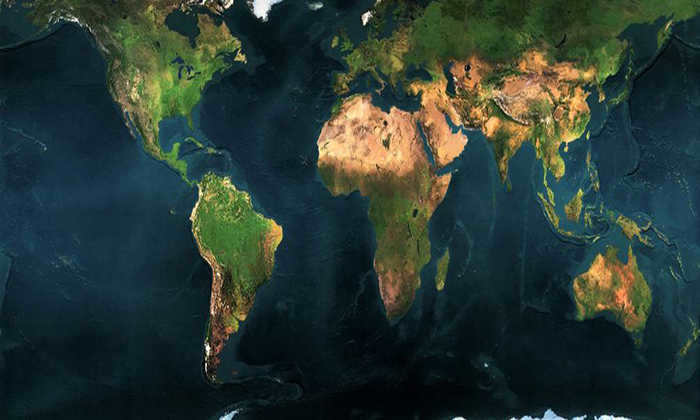
Seismology is a scientific discipline that involves the study of the Earth’s properties by analyzing seismic waves and the density of its internal materials.

The planet Earth is composed of several layers that form its structure. These layers include the crust, which is the outermost layer, the viscous mantle, and the metallic core. Together, these components make up the Earth’s composition.
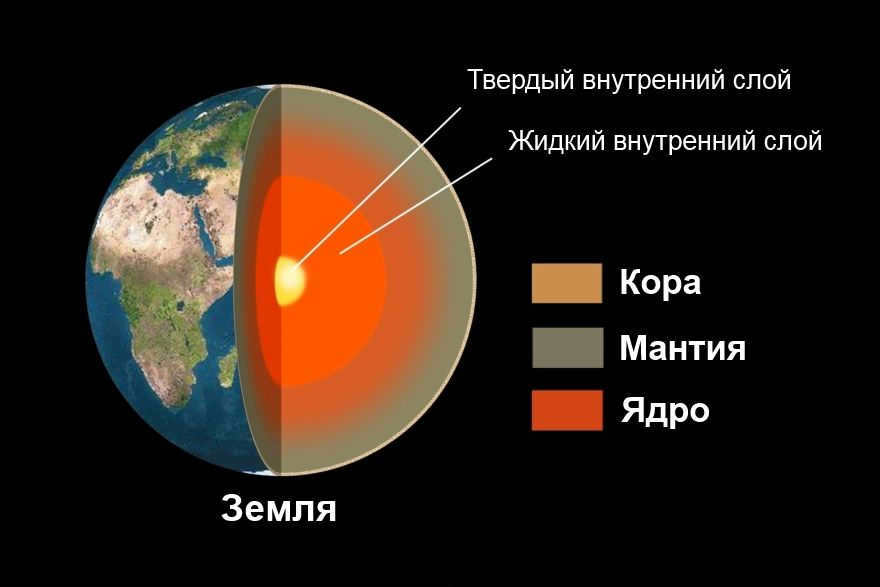
The composition of the Earth’s core can be likened to that of a peach, with a liquid outer layer and a solid inner layer. The area sandwiched between the Earth’s crust and the outer mantle is known as the lithosphere.
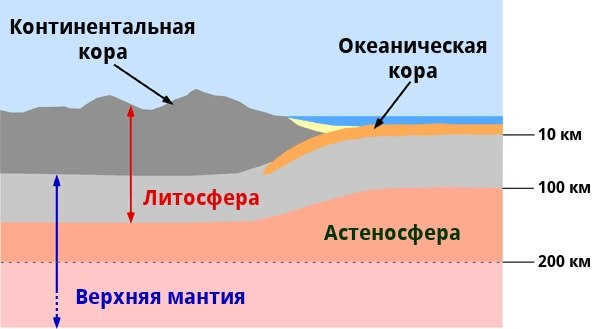
The mantle layers can be found at a depth of 660 kilometers, and with each passing year, the clarity of the boundary between these layers continues to improve. The layer itself measures about 2000 meters in thickness.
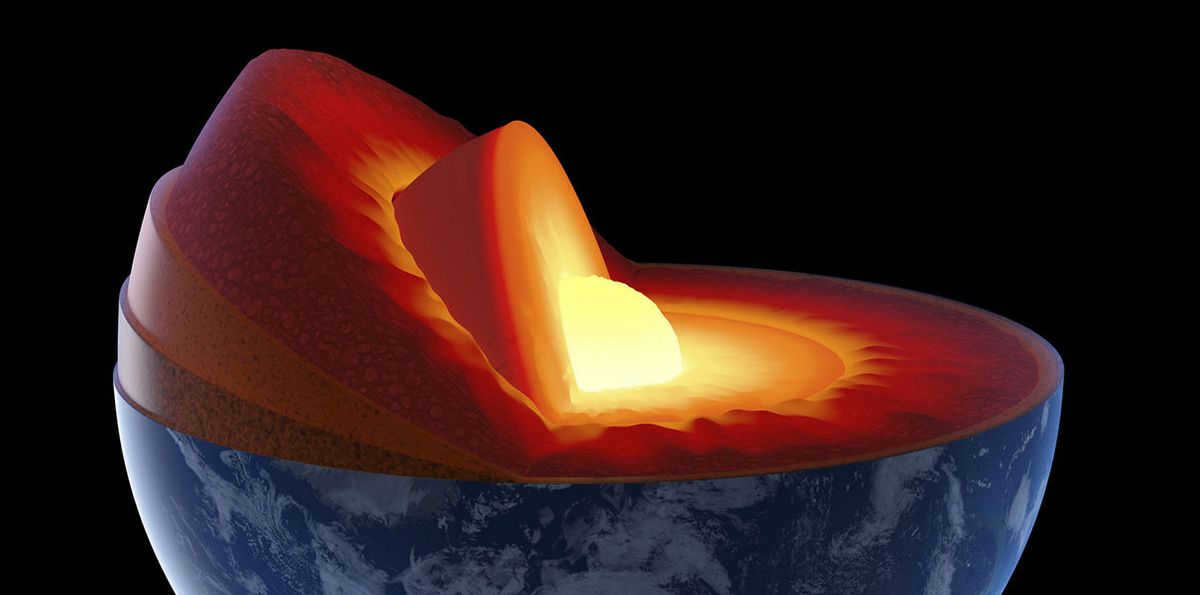
Here is where the speed of the wave alters, as well as the composition of the material. The deeper sections of the mantle can be found at a depth of 2800 km. At 4100 kilometers, the outer section of the core is in a liquid state.
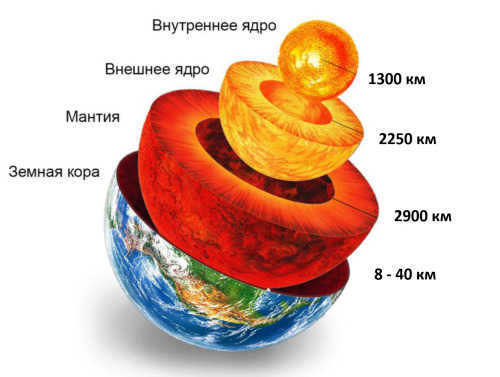
The planet Earth is located in which system? This system doesn’t permit the transmission of transverse waves. Internally, the core is compact and composed primarily of iron, possibly with traces of nickel. The innermost section of the core is situated at a depth ranging from 5100 to 6300 km.
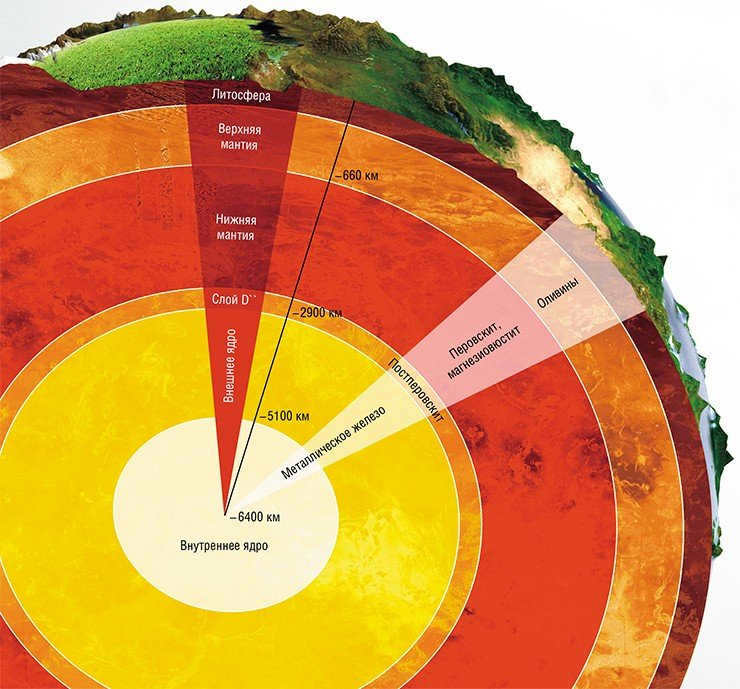
It is important to mention that the measurements are not direct, as it is impractical to reach such depths in reality. The gravitational force is determined by the gravitational pull, as described by Newton.
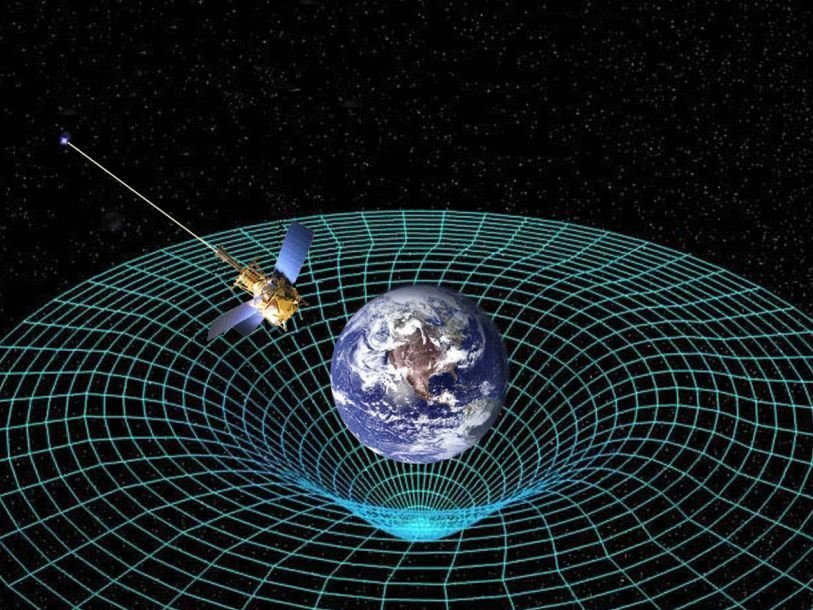
Considering the positioning of dense inhomogeneities is crucial. The planet maintains an equilibrium effect. The deeper a mountain extends into the earth, the higher its elevation.
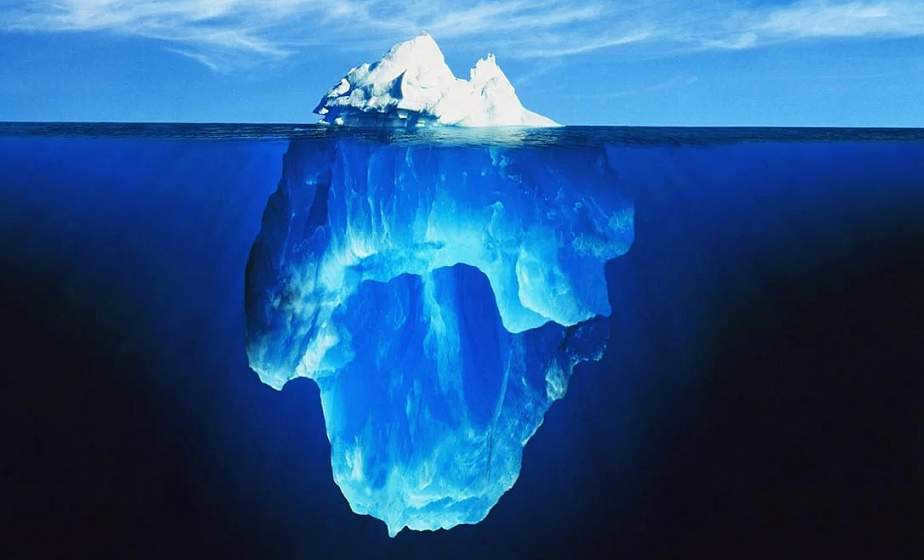
The presence of an equilibrium effect can be observed in various systems, such as an iceberg. However, it is interesting to note that the North Caucasus region is the only area where this effect does not occur. The scientific community has yet to discover the underlying cause for this exception.
The Different Layers of the Atmosphere
The atmosphere surrounding our planet is composed of various layers of gases. This protective shell extends up to a distance of 1.3 thousand kilometers at the edge of interplanetary space.
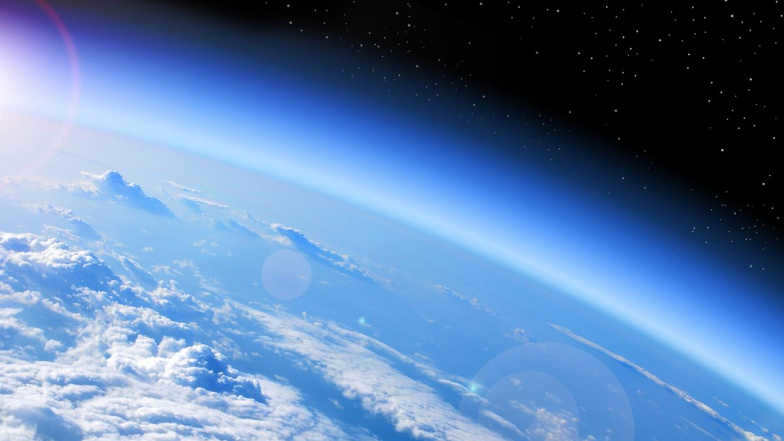
As per the official data, the planet Earth’s atmosphere boundary is located at a distance of 118 km above its surface. Any travel beyond this point is not feasible in terms of aeronautics.
The mass of air is estimated to be around 5.2×1018 kilograms. In areas near the ocean, its density is approximately 1.2 kg per 1m3.
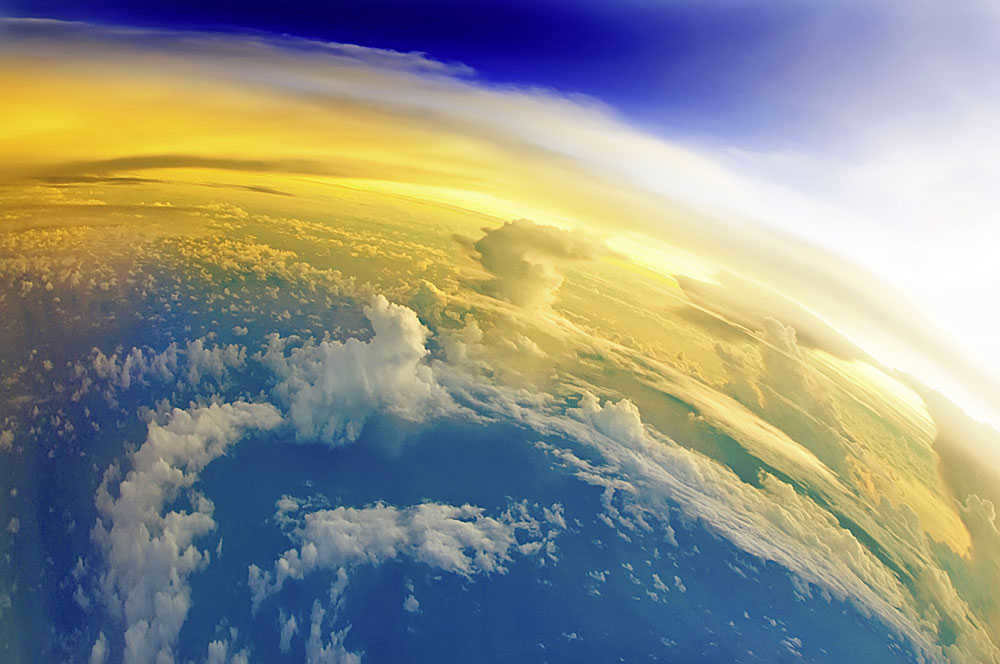
The formation of the atmosphere can be attributed to various factors, including:
- Collisions between celestial bodies and the Earth, causing the vaporization of their materials.
- Release of gases through volcanic activity, as the mantle degasses during eruptions.
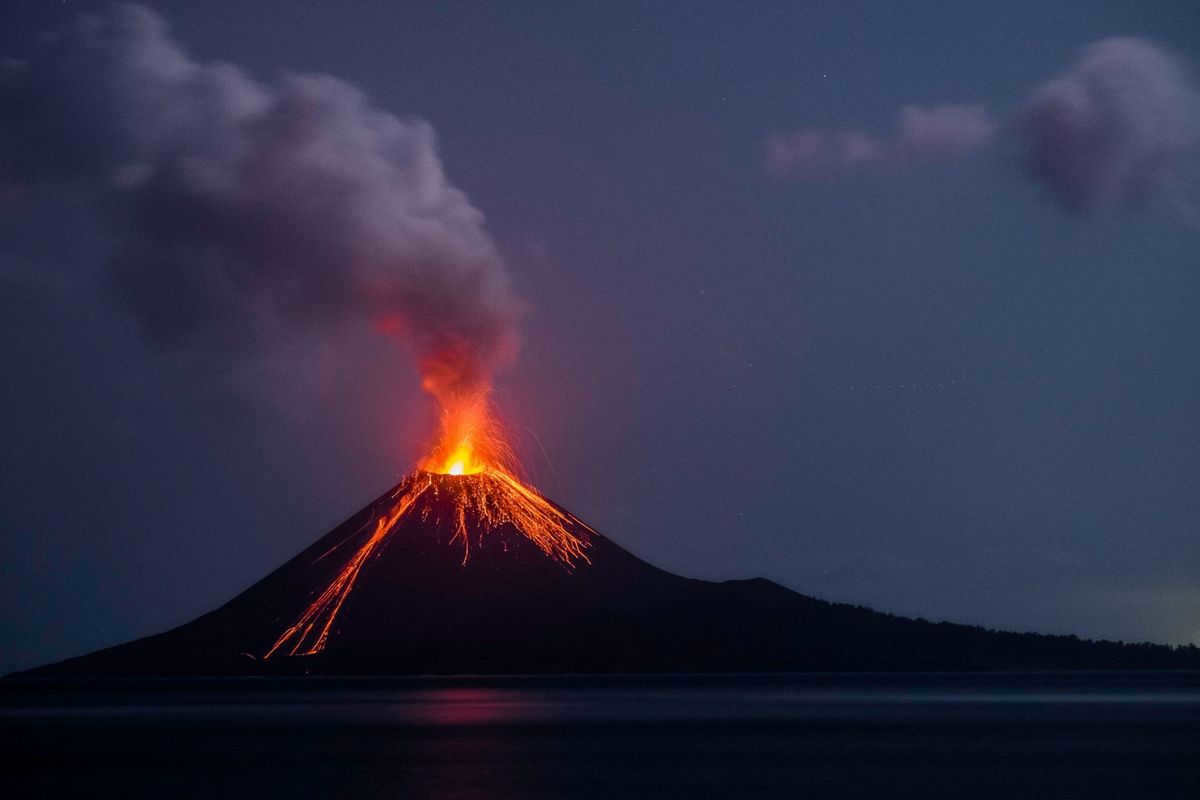
The planet Earth is located in a system that contains various layers that form its atmosphere.

- The troposphere is the most extensively researched layer. Its thickness is 9 km at the pole, 11 cm in temperate latitudes, and 17 km at the equator.


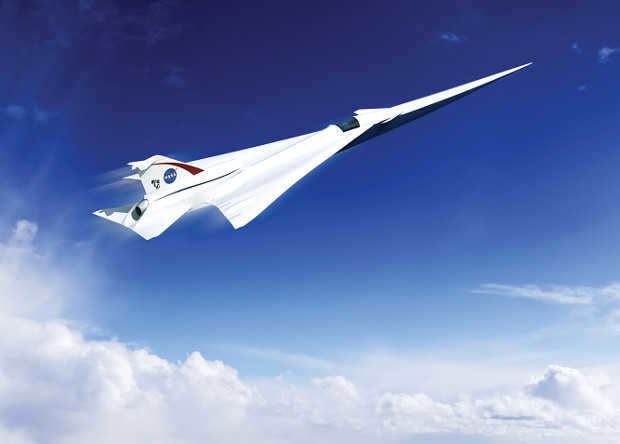

- The mesosphere begins at a height of 50 km and spans 35 km. The temperature drops by half a degree for every 100 meters of altitude.
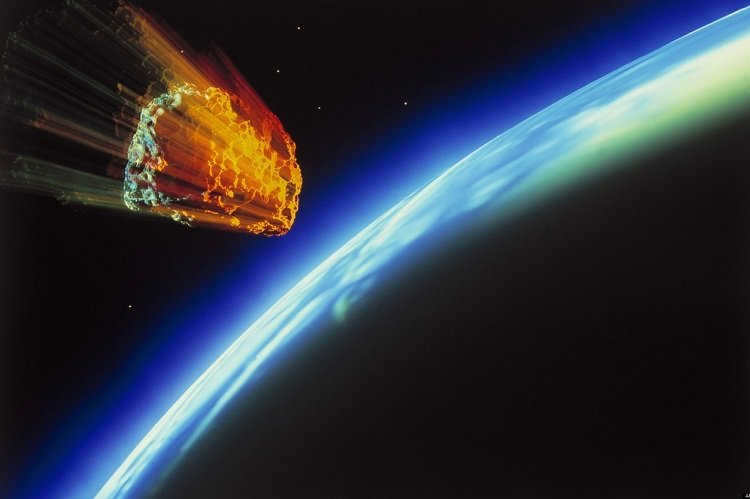
- The thermosphere is located 800 kilometers above the surface of the planet. The temperature at 250 km reaches 1500 K, and it continues to rise within these limits.

The thermosphere is the region in the Earth’s atmosphere where the phenomenon of polar lights occurs as a result of the air being ionized. The thickness of the ionosphere can vary depending on the level of solar activity.
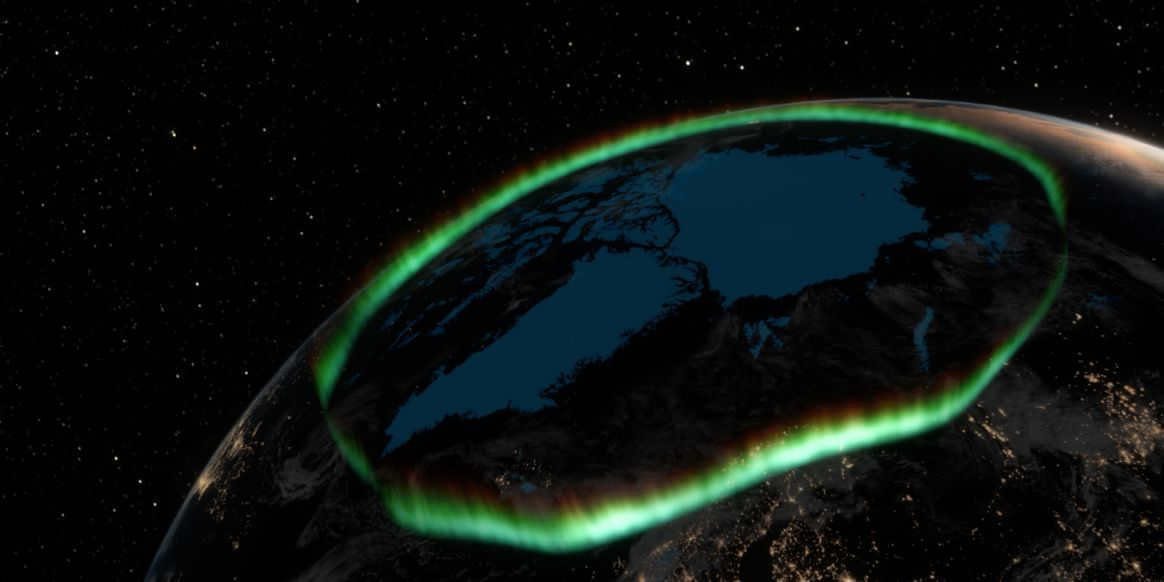
The Earth’s atmosphere is separated from space by a line known as the Karman line, which is situated 100 kilometers above sea level.
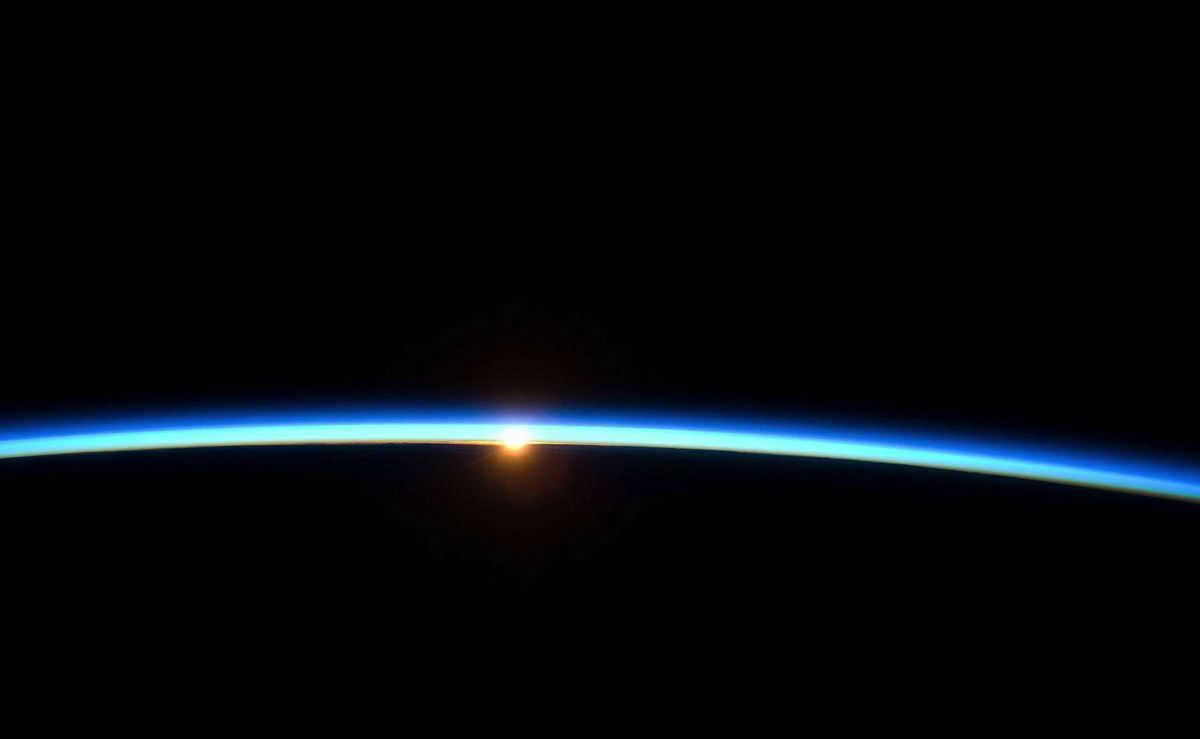

The diagram illustrates atmospheric circulation:

The aqueous covering
The Earth hosts a vast expanse of water, with a total volume of nearly 1400 million km3. This aqueous domain encompasses approximately 72% of the planet’s surface. The average mass of this hydrosphere is approximately 1.5×1021 kg, exceeding the weight of the atmosphere by nearly 300-fold.
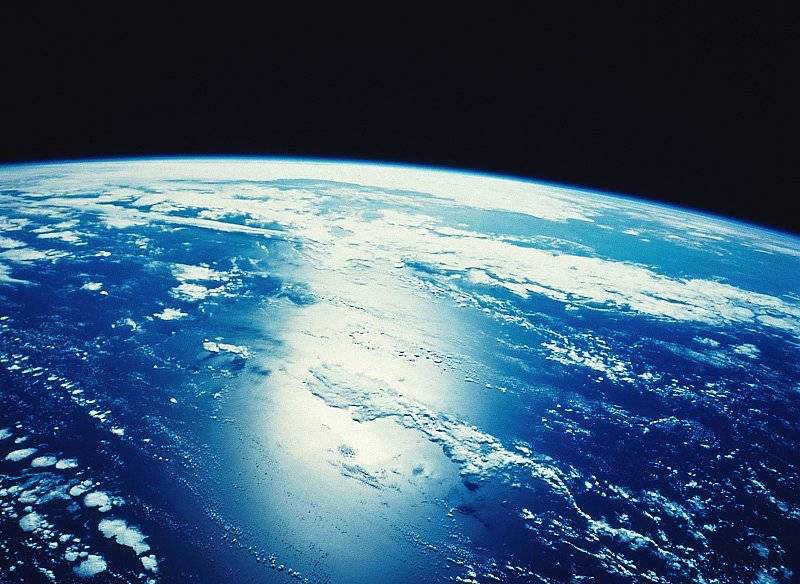
Nevertheless, in relation to the globe, this statistic is relatively minuscule. The Mariinsky Depression is acknowledged as the most profound point, boasting a depth of nearly 11 kilometers. On average, the world’s ocean has a depth of approximately 3.8 km. Superficial waters hold little significance.
Nonetheless, they possess a substantial impact on the biosphere, which occupies the earth’s outermost layer.
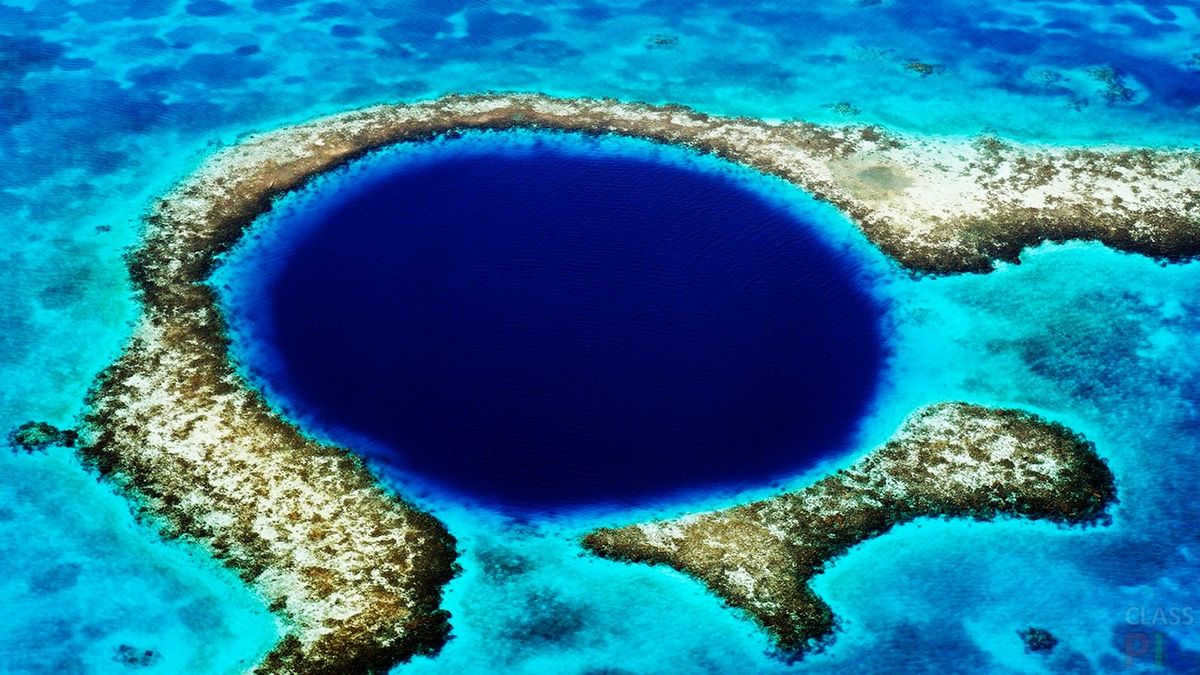
The planet Earth is located in a system that plays a vital role in supporting life. One of the key elements of this system is water, which not only ensures the supply of water to all living things, but also plays a crucial role in irrigating the soil. When water is in a solid state, it forms the cryosphere, which has a significant impact on the climate of the entire planet.
The Magnetism of the Planet
It is important to mention that the planet possesses the structure of a magnet, as it is characterized by both a northern and southern pole. The northern side of the planet is marked by inwardly-directed lines of force, while the southern side exhibits lines that radiate outward.
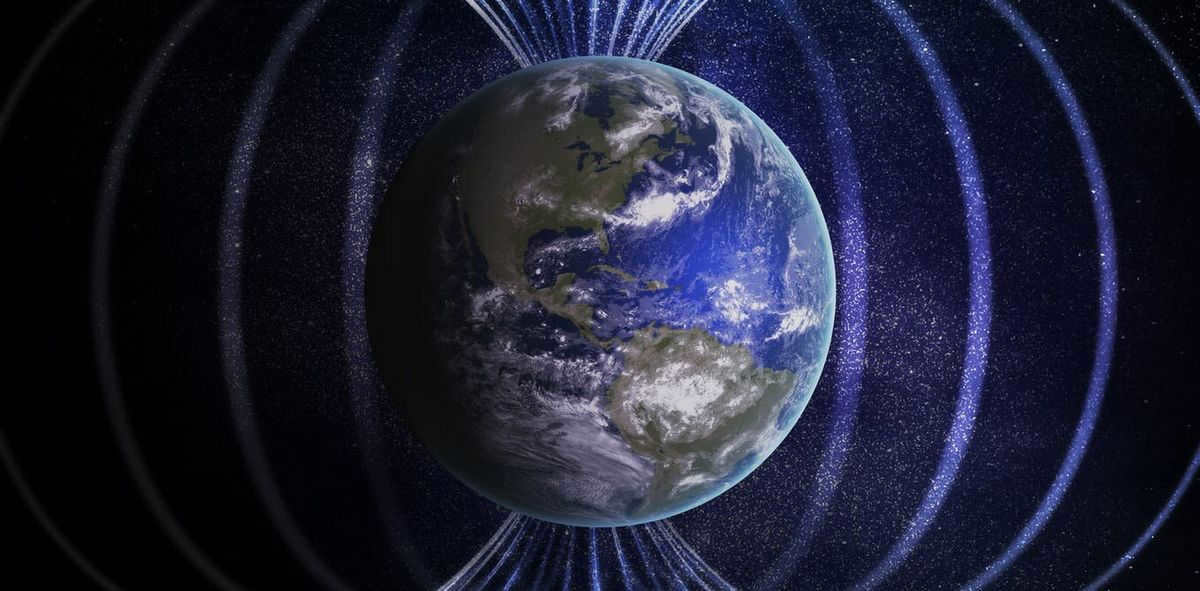
The Earth’s planetary system is home to our planet, which is known for its constantly shifting and changing magnetic pole. At the equator, the induction values measure 3×10-5 Tesla, while the magnetic moment values are nearly 8×1015 Tesla per 1m. Despite these figures, the magnetic field strength remains relatively weak.
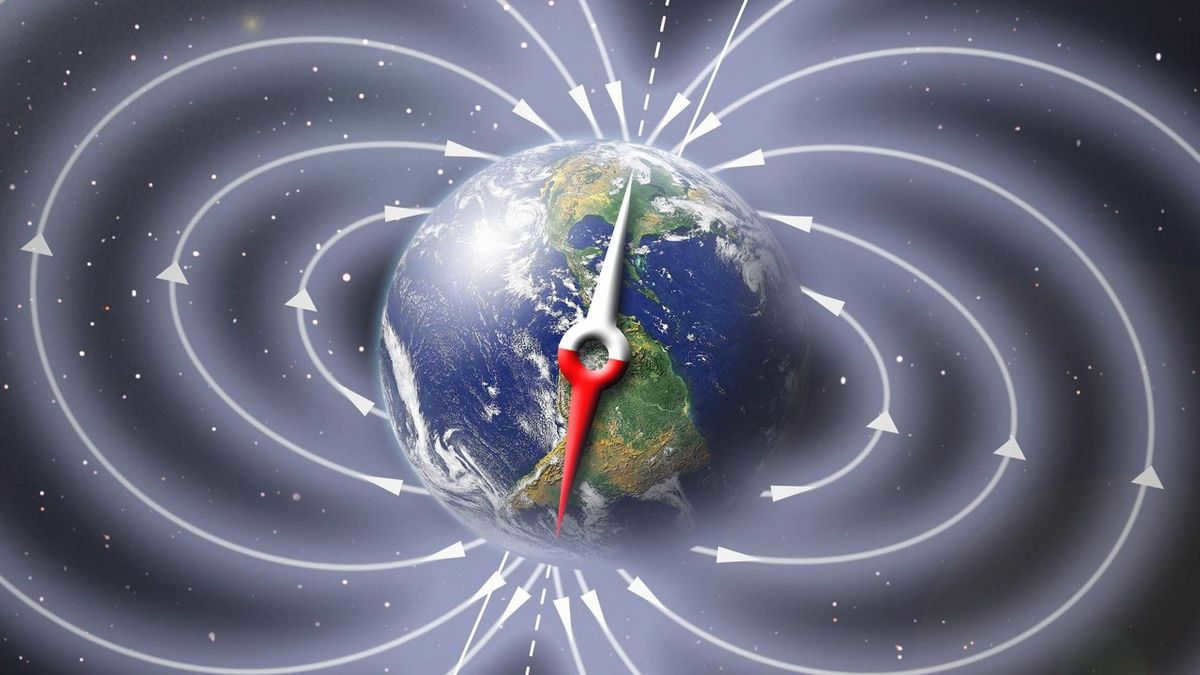
Magnets have been placed on the cabinet doors, with a strength that is 300 times more powerful. Researchers were able to ascertain that the magnetic field switched polarity thousands of times.
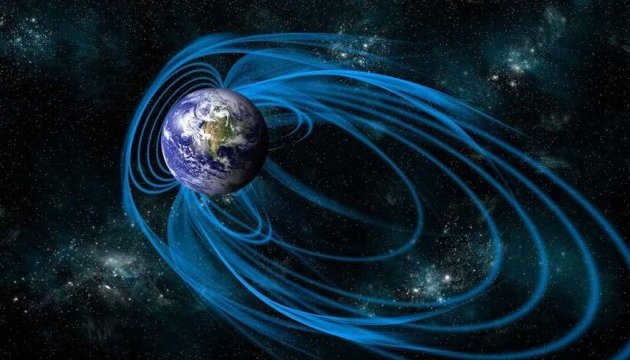
The identification of this fact was aided by the residual magnetization. The magnetic field in question generates a magnetosphere that acts as a shield against solar ultraviolet radiation. This provides an extra layer of protection for all organisms inhabiting the planet.
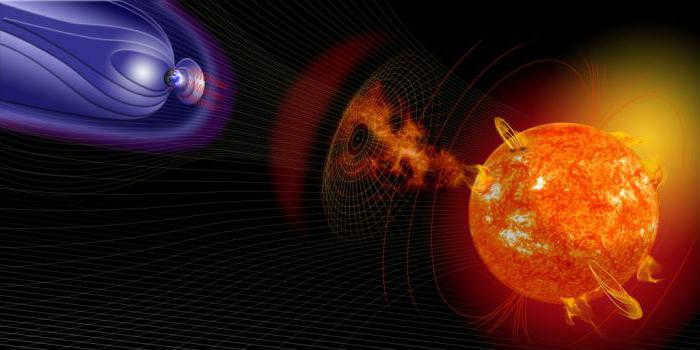
Currently, the origin of the Earth’s magnetic field remains unknown and scientists can only offer theories. The exact timeframe in which the magnetic field formed is also uncertain. In a recent discovery in Australia, zircon was found with an age of 4.3 billion years, and it still retained some magnetization. However, this phenomenon continues to puzzle researchers.

Curious information
As previously stated, the Mariana Trench is recognized as the lowest point on Earth. It was first explored in the 1870s. The highest point is known as Mount Everest, also referred to as Jomolungma. The elevation of this peak reaches 8.848 kilometers. It is worth mentioning that the height decreases each year.
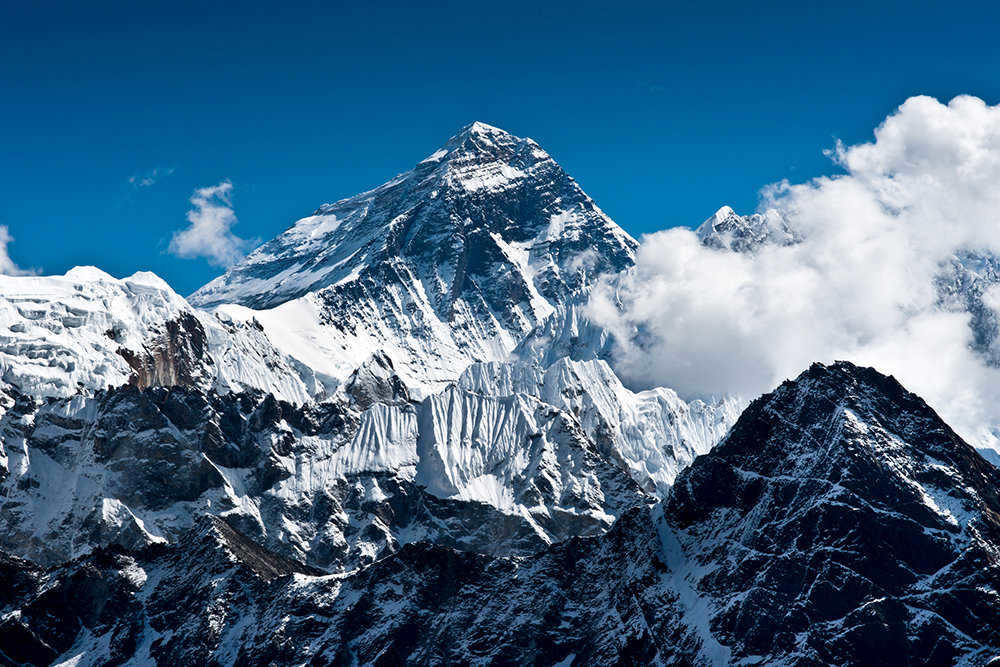
The reason for this phenomenon is the interaction of wind patterns with the rocky terrain. The Kola Peninsula is home to the deepest well on Earth, situated approximately 10 km away from the town of Zapolyarny. Its impressive depth reaches 12.2 km.
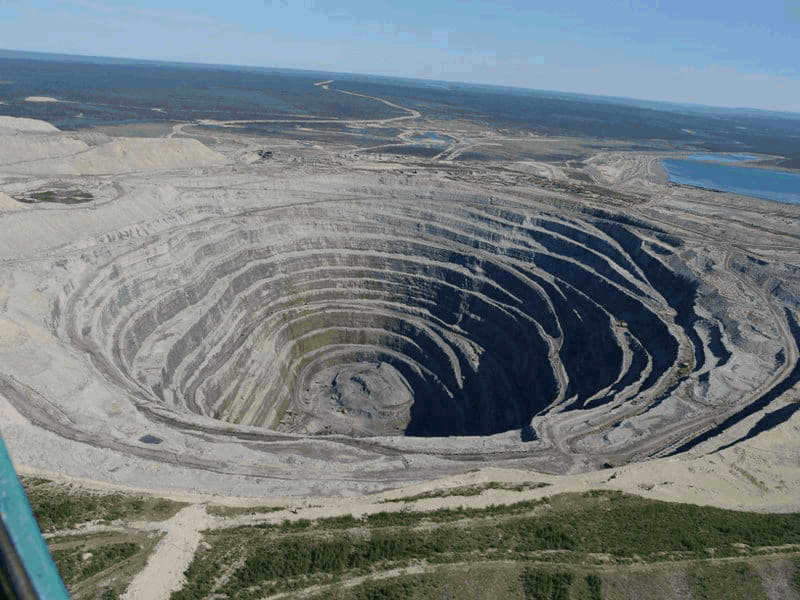
Within the confines of our world, there exists a specific location where an individual would experience less weight than a mosquito. This extraordinary point is situated at the very core of our planet, where the force of gravity becomes null and void.
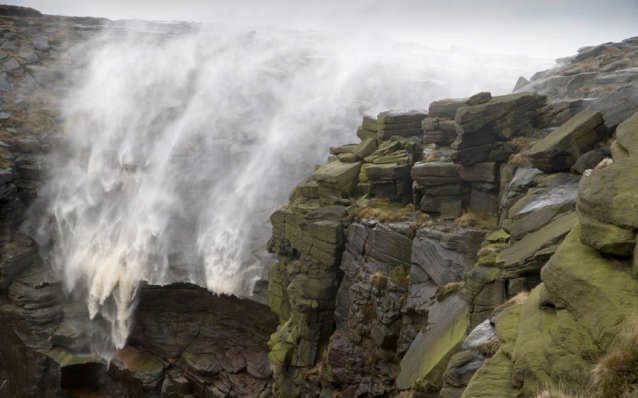
One of the most captivating sights on Earth is undoubtedly the aurora borealis. This mesmerizing phenomenon occurs when the upper layers of our atmosphere start emitting a radiant glow. It is caused by the interaction between these layers and the charged particles from the solar wind, resulting in a breathtaking display of vibrant colors.

The planet Earth is located in which system? Antarctica contains two-thirds of the planet’s fresh water reserves. If the ice melts simultaneously, the global sea level will increase by nearly 0.9 km. Each day, one hundred thousand tons of cosmic dust fall onto the Earth. Nevertheless, most of it gets incinerated in the atmospheric layers.
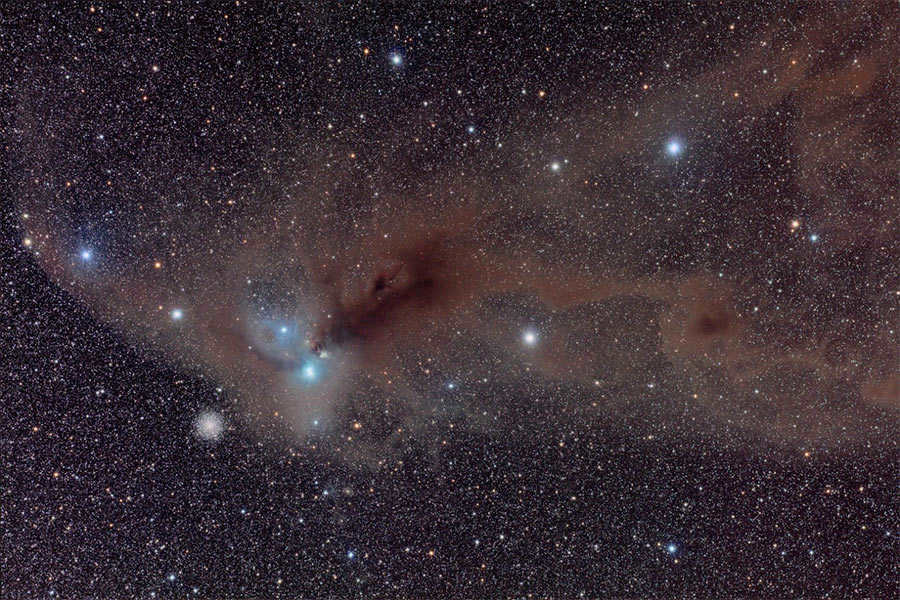
Knowing the age and origin of our planet is important knowledge. Currently, Earth is the only known planet that can sustain life. The atmosphere of our planet shields us from harmful ultraviolet radiation and space debris. Scientists continuously strive to unravel the mysteries of Earth, but it is a challenging task.





